大纲



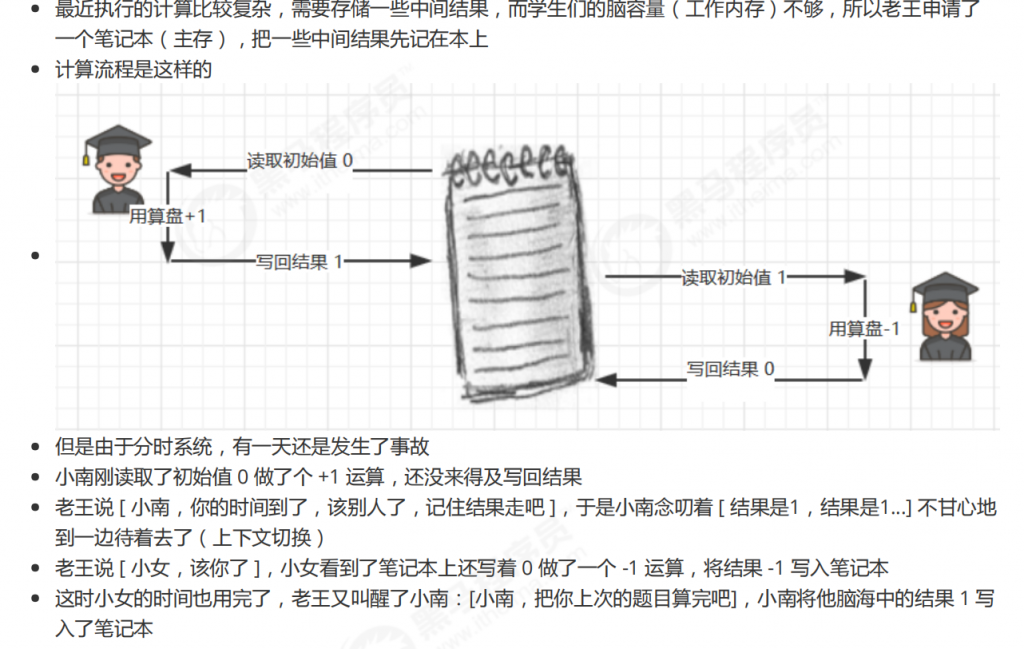


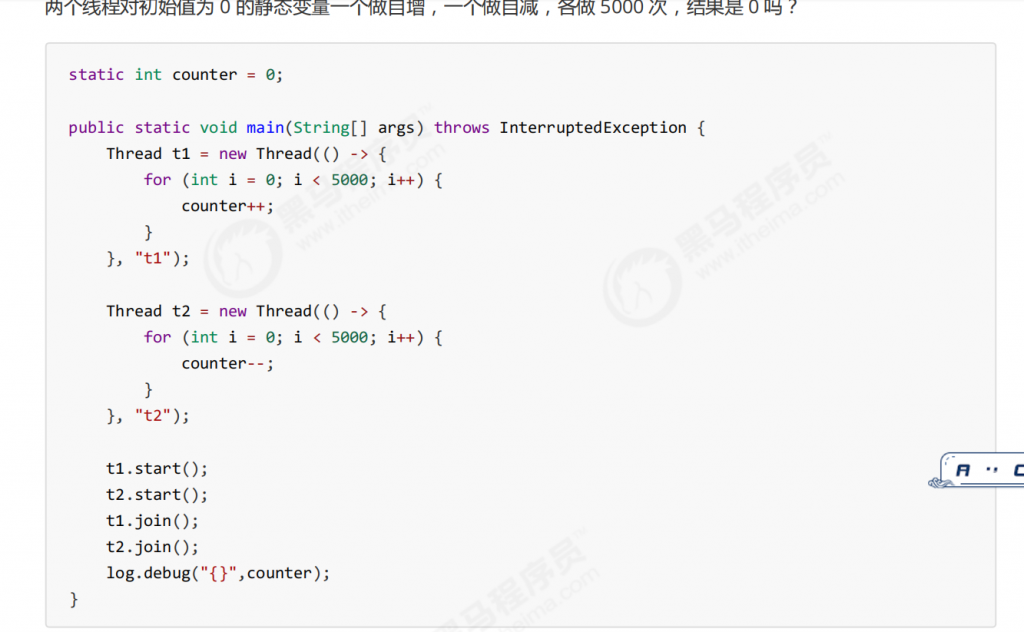
实际测试


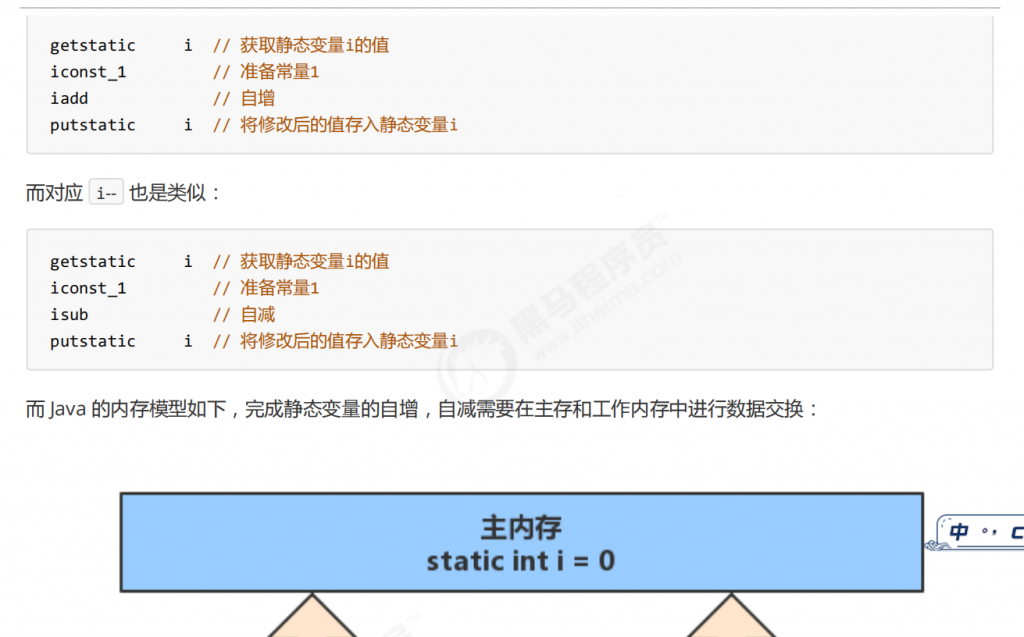
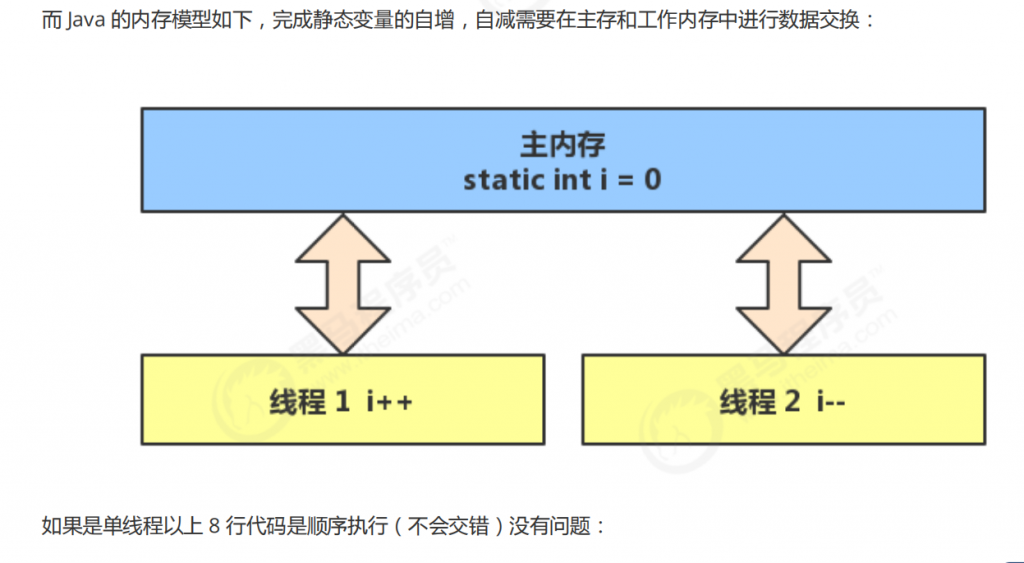






使用synchronized关键字解决问题:
@Slf4j
public class Test16 {
static int count = 0;
static Object lock = new Object();
public static void main(String[] args) throws InterruptedException {
Thread t1 = new Thread(() -> {
for (int i = 0; i < 5000; i++) {
synchronized (lock){
count++;
}
}
},"老王");
Thread t2 = new Thread(() -> {
for (int i = 0; i < 5000; i++) {
synchronized (lock){
count--;
}
}
},"小王");
t1.start();
t2.start();
t1.join();
t2.join();
log.debug("{}",count);
}
}理解一下:

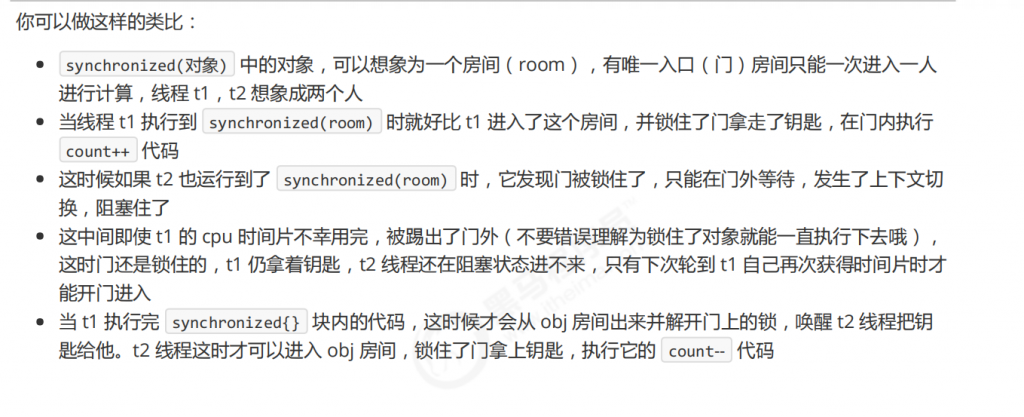
用图来表示:



用面向对象的方法去改造代码:
@Slf4j
public class Test16 {
public static void main(String[] args) throws InterruptedException {
Room room = new Room();
Thread t1 = new Thread(() -> {
for (int i = 0; i < 5000; i++) {
room.increment();
}
},"老王");
Thread t2 = new Thread(() -> {
for (int i = 0; i < 5000; i++) {
room.decrement();
}
},"小王");
t1.start();
t2.start();
t1.join();
t2.join();
log.debug("{}",room.getCount());
}
}
class Room{
private int count = 0;
public void increment(){
synchronized (this){
count++;
}
}
public void decrement(){
synchronized (this){
count--;
}
}
public int getCount(){
synchronized (this){
return count;
}
}
}


线程8锁问题:
@Slf4j
public class Test8Locks {
public static void main(String[] args) {
Number number = new Number();
new Thread(()->{
log.debug("begin");
number.a();
}).start();
new Thread(()->{
log.debug("begin");
number.b();
}).start();
}
}
@Slf4j
class Number{
public synchronized void a(){
log.debug("1");
}
public synchronized void b(){
log.debug("2");
}
}
那么这里锁住的都是number对象 这时会出现12或者21的情况;

情况2:
@Slf4j
public class Test8Locks {
public static void main(String[] args) {
Number number = new Number();
new Thread(()->{
log.debug("begin");
try {
number.a();
} catch (InterruptedException e) {
e.printStackTrace();
}
}).start();
new Thread(()->{
log.debug("begin");
number.b();
}).start();
}
}
@Slf4j
class Number{
public synchronized void a() throws InterruptedException {
Thread.sleep(1000);
log.debug("1");
}
public synchronized void b(){
log.debug("2");
}
}在a的方法中加入sleep;那么会出现两种情况,,但是因为还是锁同一个this对象,所以还是互斥,需要等待;


情况3:

@Slf4j
public class Test8Locks {
public static void main(String[] args) {
Number number = new Number();
new Thread(()->{
log.debug("begin");
try {
number.a();
} catch (InterruptedException e) {
e.printStackTrace();
}
}).start();
new Thread(()->{
log.debug("begin");
number.b();
}).start();
new Thread(()->{
log.debug("begin");
number.c();
}).start();
}
}
@Slf4j
class Number{
public synchronized void a() throws InterruptedException {
Thread.sleep(1000);
log.debug("1");
}
public synchronized void b(){
log.debug("2");
}
public void c(){
log.debug("3");
}
}

情况4:
@Slf4j
public class Test8Locks {
public static void main(String[] args) {
Number number = new Number();
Number number2 = new Number();
new Thread(()->{
log.debug("begin");
try {
number.a();
} catch (InterruptedException e) {
e.printStackTrace();
}
}).start();
new Thread(()->{
log.debug("begin");
number2.b();
}).start();
// new Thread(()->{
// log.debug("begin");
// number.c();
// }).start();
}
}
@Slf4j
class Number{
public synchronized void a() throws InterruptedException {
Thread.sleep(1000);
log.debug("1");
}
public synchronized void b(){
log.debug("2");
}
}由于锁住的不是同一个对象,所以永远都是21
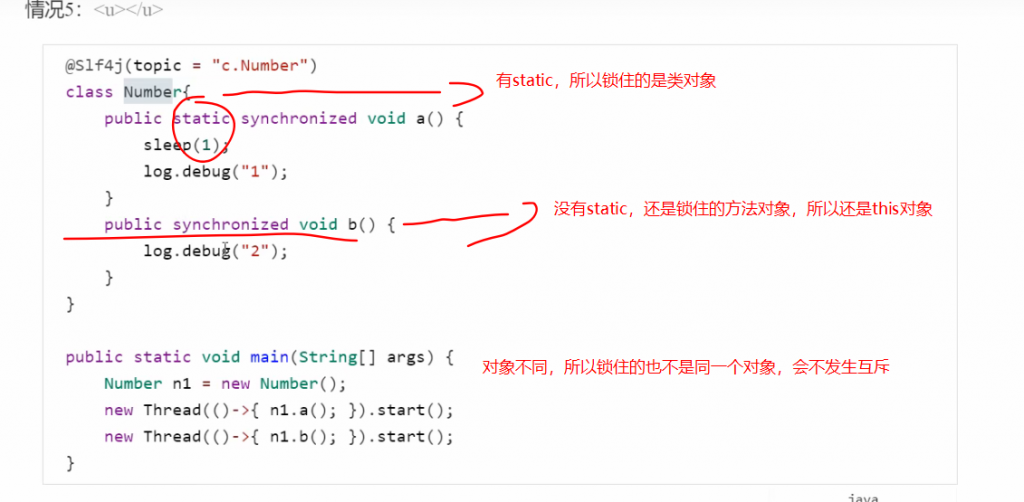

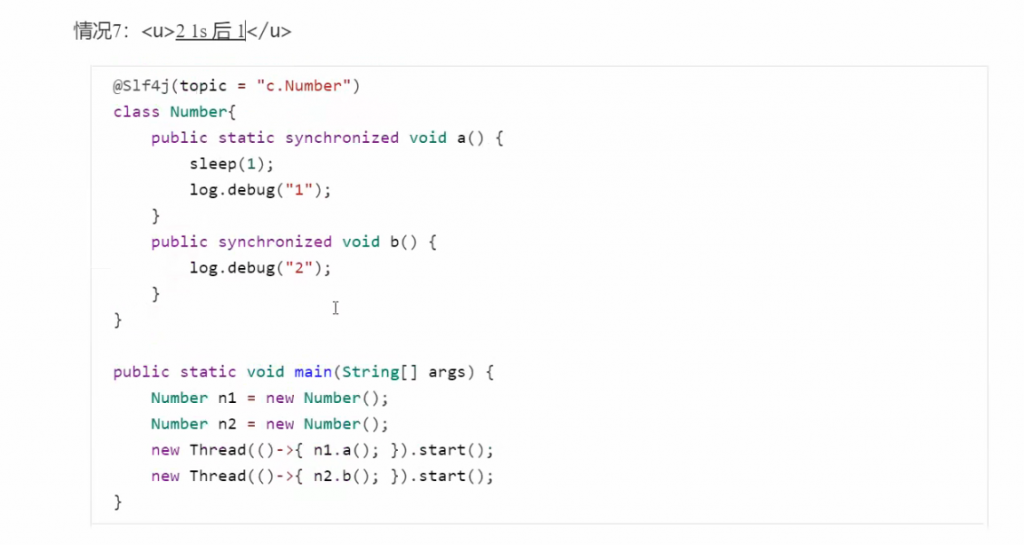
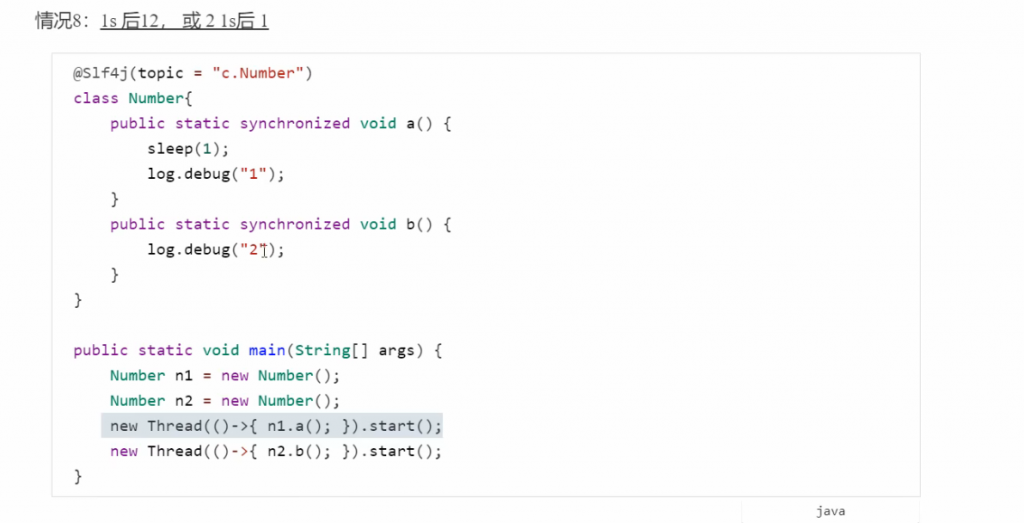
4.4 变量的线程安全分析




@Slf4j
public class Test18 {
public static void main(String[] args) {
ThreadUnsafe threadUnsafe = new ThreadUnsafe();
for (int i = 0; i < 2; i++) {
new Thread(()->{
threadUnsafe.method1(200);
},"thread"+(i+1)).start();
}
}
}
class ThreadUnsafe{
ArrayList<String> list = new ArrayList<>();
public void method1(int loopNumber){
for (int i = 0; i < loopNumber; i++) {
//{临界区,会产生竞态条件}
method2();
method3();
}
}
private void method3() {
list.add("1");
}
private void method2() {
list.remove(0);
}
}
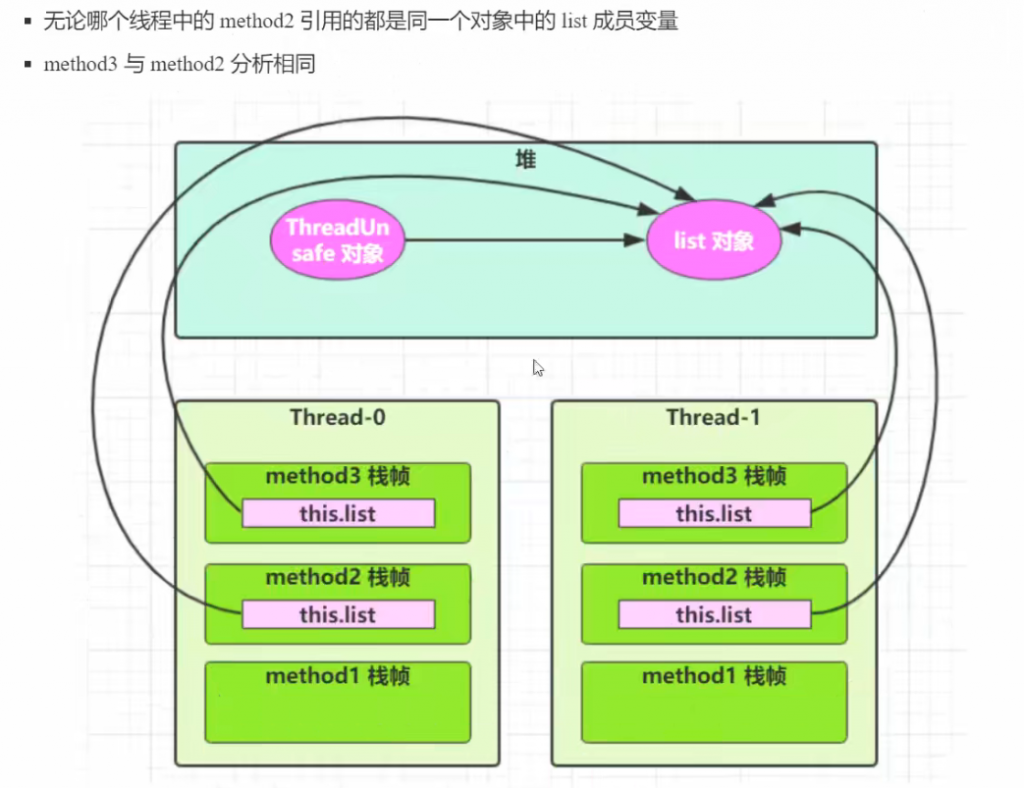
变为局部变量:


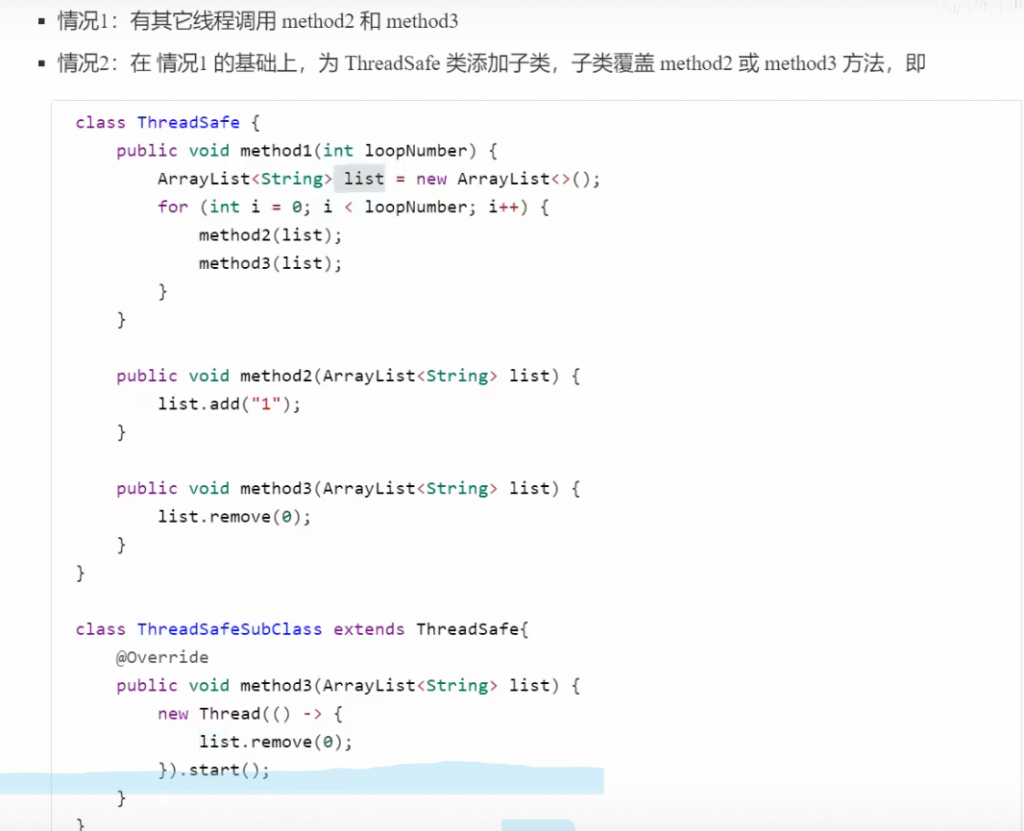
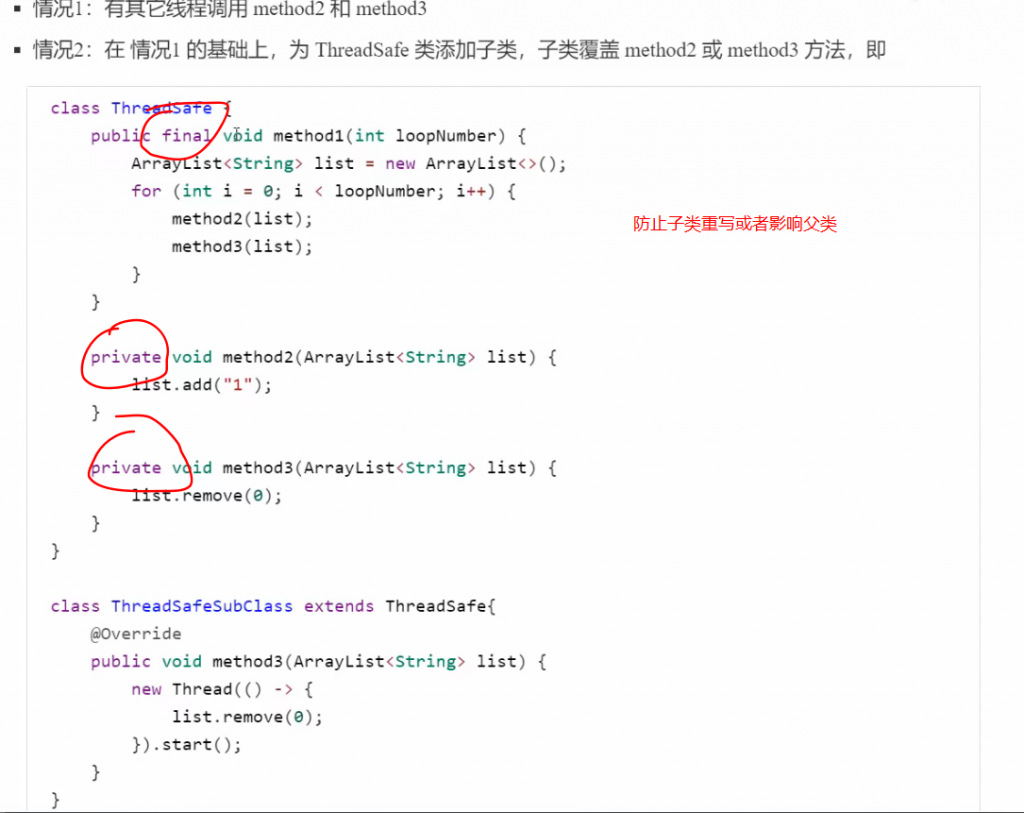
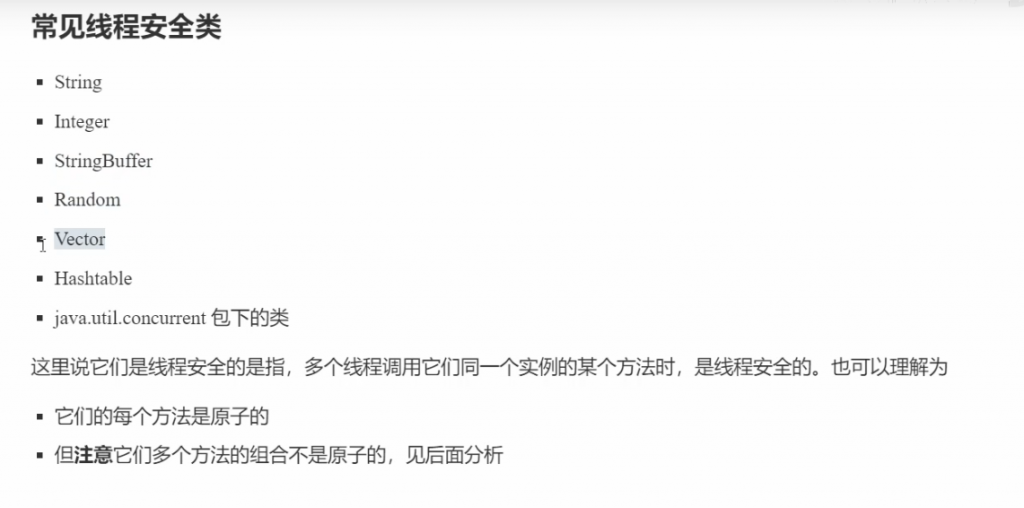




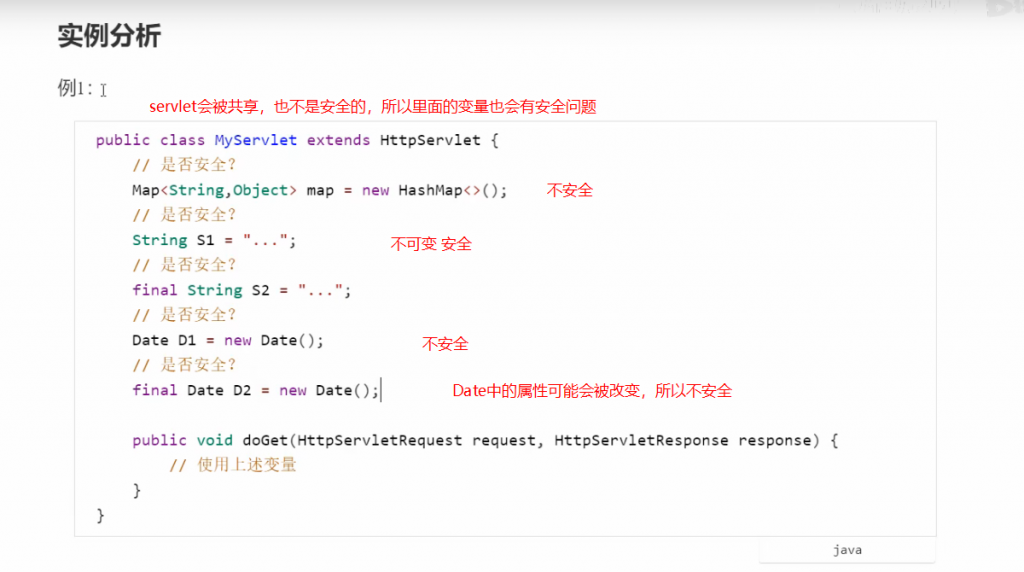
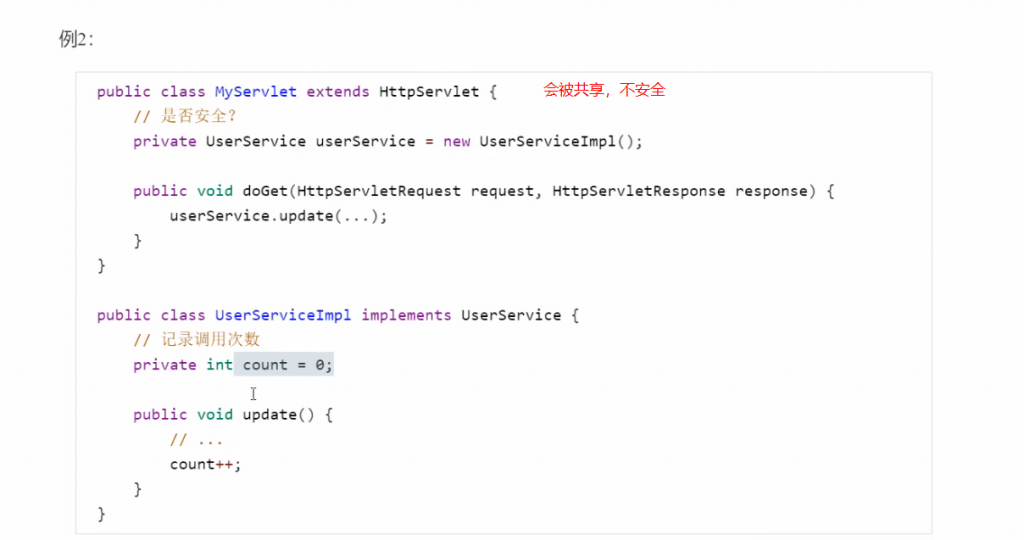
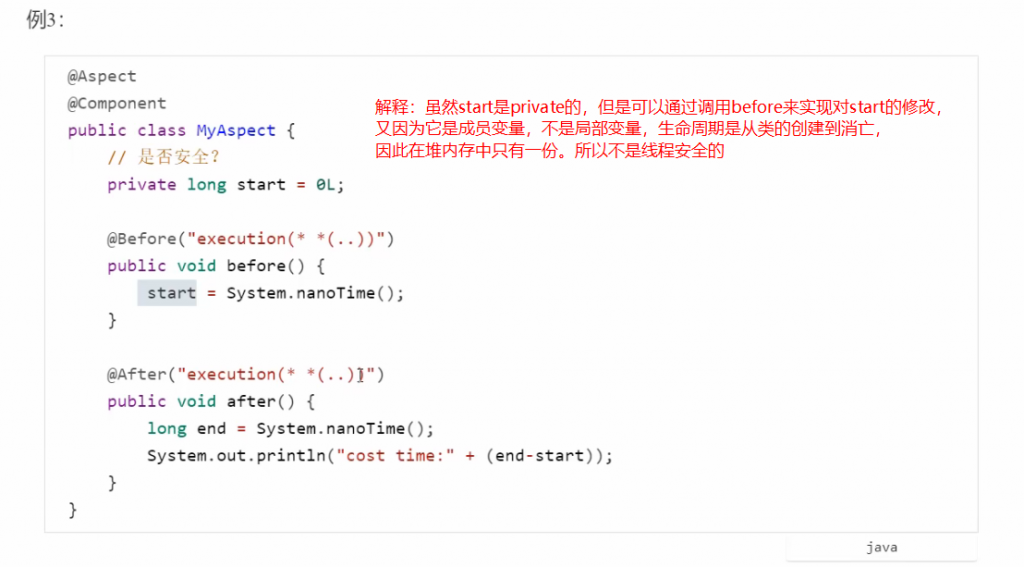


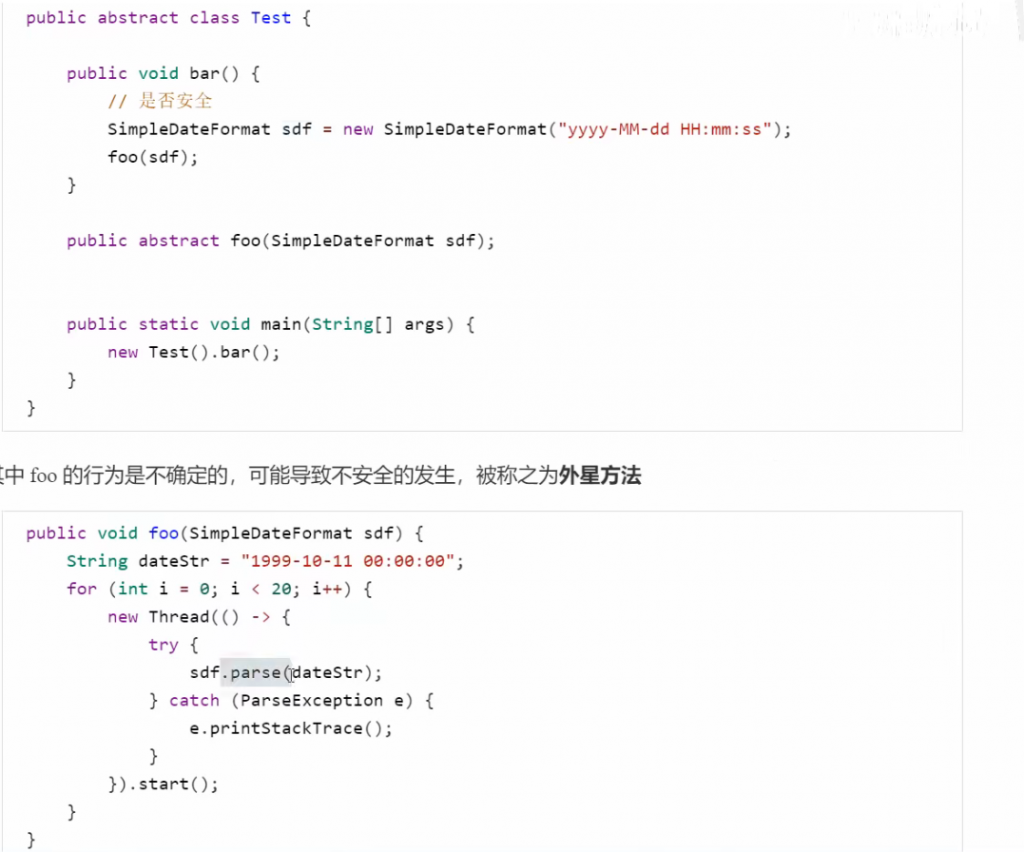

练习题:
TicketWindow
package com.example.juc.test;
import lombok.extern.slf4j.Slf4j;
@Slf4j
//售票窗口
public class TicketWindow {
private int count;
public TicketWindow(int count){
this.count = count;
}
//获取余票数量:
public int getCount(){
return count;
}
//售票:
public synchronized int sell(int amount){
if(this.count >amount){
this.count -= amount;
return amount;
}else {
return 0;
}
}
}
售卖类:
package com.example.juc.test;
import lombok.extern.slf4j.Slf4j;
import java.util.ArrayList;
import java.util.List;
import java.util.Random;
import java.util.Vector;
@Slf4j
public class ExerciseSell {
public static void main(String[] args) throws InterruptedException {
//模拟多人买票
TicketWindow window = new TicketWindow(1000);
//所有线程的集合
List<Thread> threadList = new ArrayList<>();
//卖出的票数统计:
List<Integer> amountlist = new Vector<>();
for (int i = 0; i <5000 ; i++) {
Thread thread = new Thread(() -> {
//买票
int sellcount = window.sell(randomAmount());
try {
Thread.sleep(randomAmount());
} catch (InterruptedException e) {
e.printStackTrace();
}
amountlist.add(sellcount);
});
threadList.add(thread);
thread.start();
}
for (Thread thread : threadList) {
thread.join();
}
//同级卖出的票数和剩余的票数:
log.debug("余票:{}",window.getCount());
log.debug("卖出的票数:{}",amountlist.stream().mapToInt(i ->i).sum());
}
//Random 为线程安全
static Random random = new Random();
//随机1 - 5
public static int randomAmount(){
return random.nextInt(5)+1;
}
}

4.6 Monitor 概念
Java 对象头
以 32 位虚拟机为例

* 原理之 Monitor(锁)
* 原理之 synchronized
小故事
故事角色
老王 – JVM
小南 – 线程
小女 – 线程
房间 – 对象
房间门上 – 防盗锁 – Monitor
房间门上 – 小南书包 – 轻量级锁
房间门上 – 刻上小南大名 – 偏向锁
批量重刻名 – 一个类的偏向锁撤销到达 20 阈值
不能刻名字 – 批量撤销该类对象的偏向锁,设置该类不可偏向
小南要使用房间保证计算不被其它人干扰(原子性),最初,他用的是防盗锁,当上下文切换时,锁住门。这样,
即使他离开了,别人也进不了门,他的工作就是安全的。
但是,很多情况下没人跟他来竞争房间的使用权。小女是要用房间,但使用的时间上是错开的,小南白天用,小女
晚上用。每次上锁太麻烦了,有没有更简单的办法呢?
小南和小女商量了一下,约定不锁门了,而是谁用房间,谁把自己的书包挂在门口,但他们的书包样式都一样,因
此每次进门前得翻翻书包,看课本是谁的,如果是自己的,那么就可以进门,这样省的上锁解锁了。万一书包不是
自己的,那么就在门外等,并通知对方下次用锁门的方式。
后来,小女回老家了,很长一段时间都不会用这个房间。小南每次还是挂书包,翻书包,虽然比锁门省事了,但仍
然觉得麻烦。
于是,小南干脆在门上刻上了自己的名字:【小南专属房间,其它人勿用】,下次来用房间时,只要名字还在,那
么说明没人打扰,还是可以安全地使用房间。如果这期间有其它人要用这个房间,那么由使用者将小南刻的名字擦
掉,升级为挂书包的方式。
同学们都放假回老家了,小南就膨胀了,在 20 个房间刻上了自己的名字,想进哪个进哪个。后来他自己放假回老
家了,这时小女回来了(她也要用这些房间),结果就是得一个个地擦掉小南刻的名字,升级为挂书包的方式。老
王觉得这成本有点高,提出了一种批量重刻名的方法,他让小女不用挂书包了,可以直接在门上刻上自己的名字
后来,刻名的现象越来越频繁,老王受不了了:算了,这些房间都不能刻名了,只能挂书包
* 原理之 synchronized 进阶
轻量级锁:
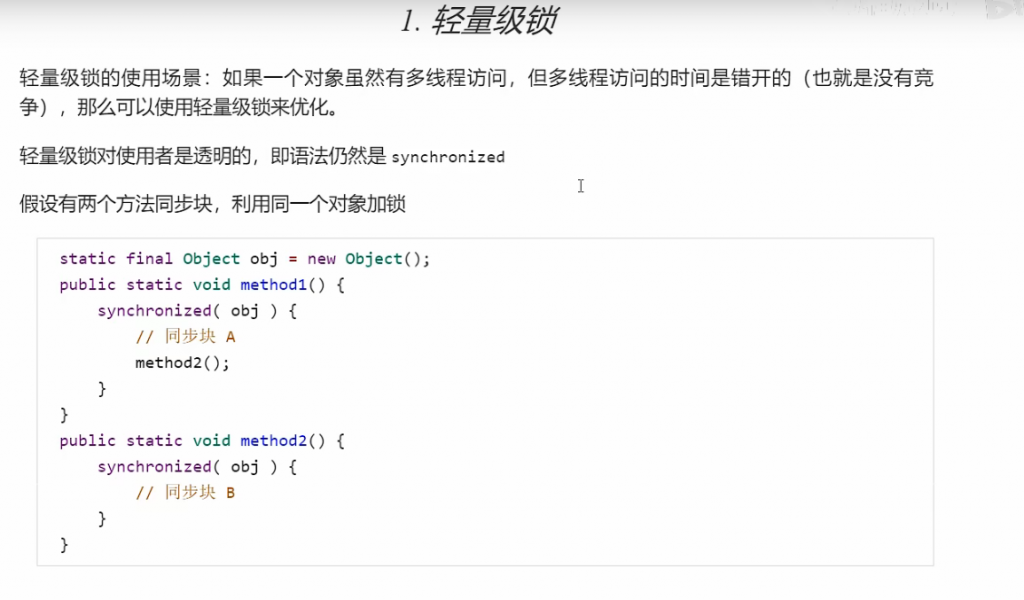








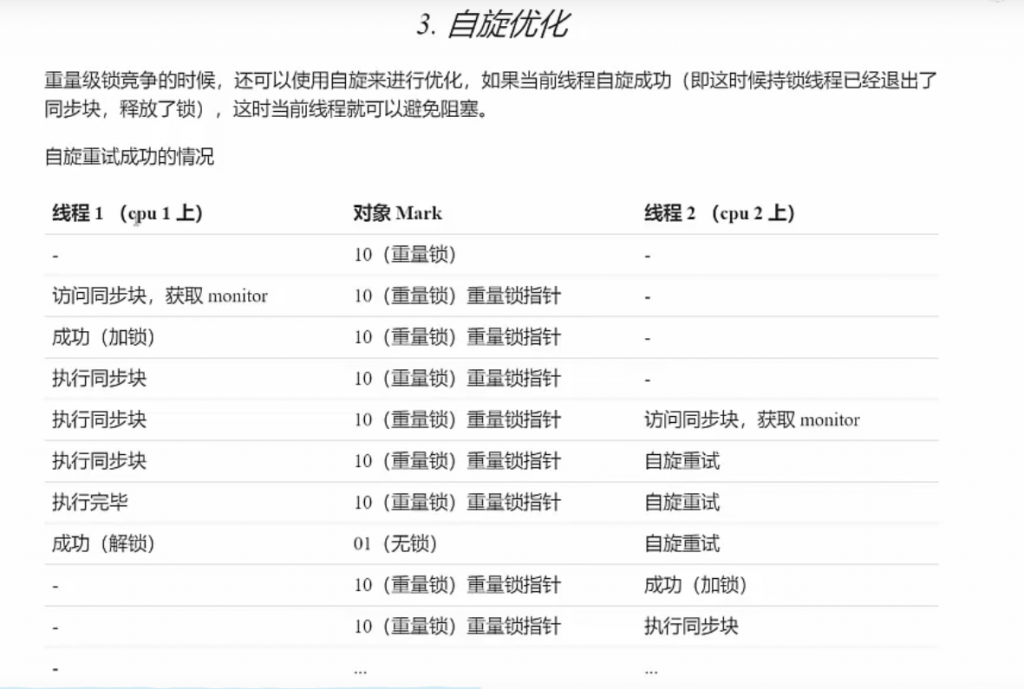




偏向状态


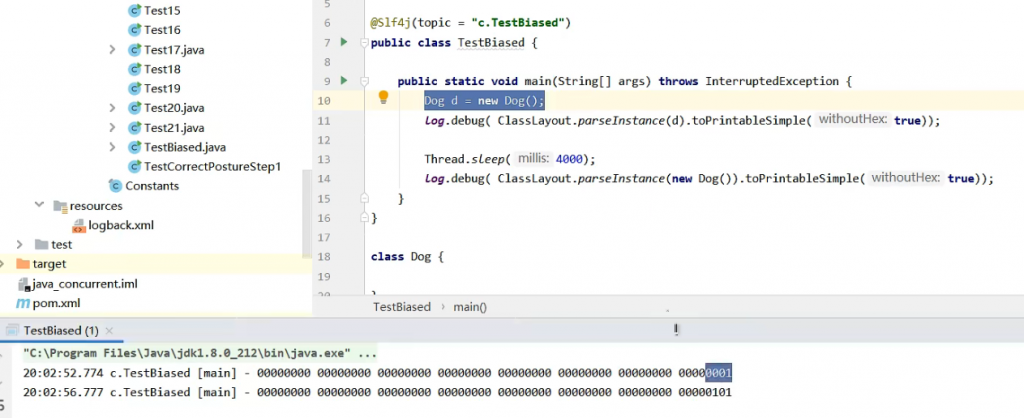

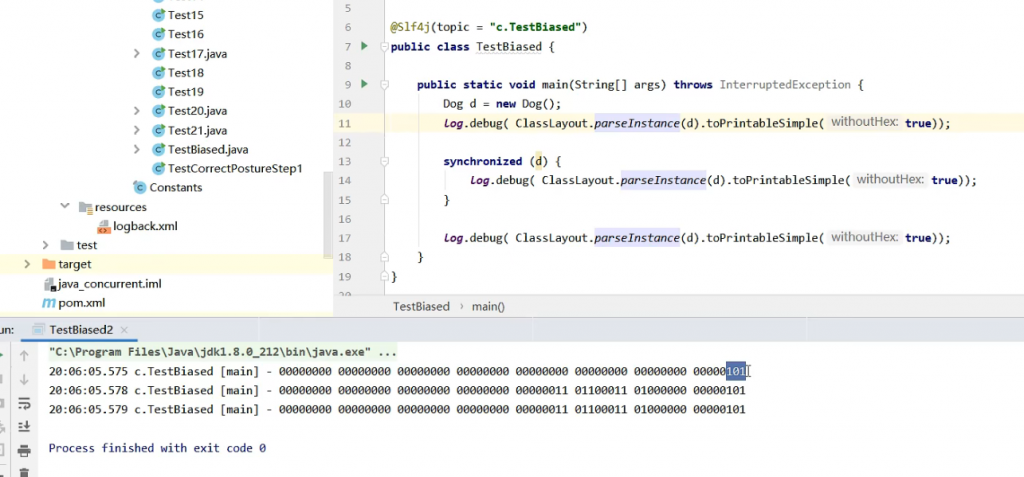
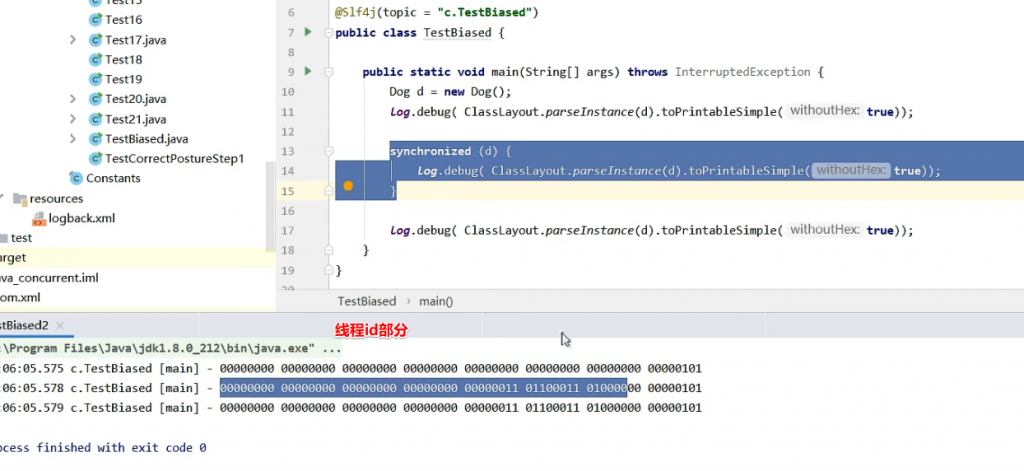

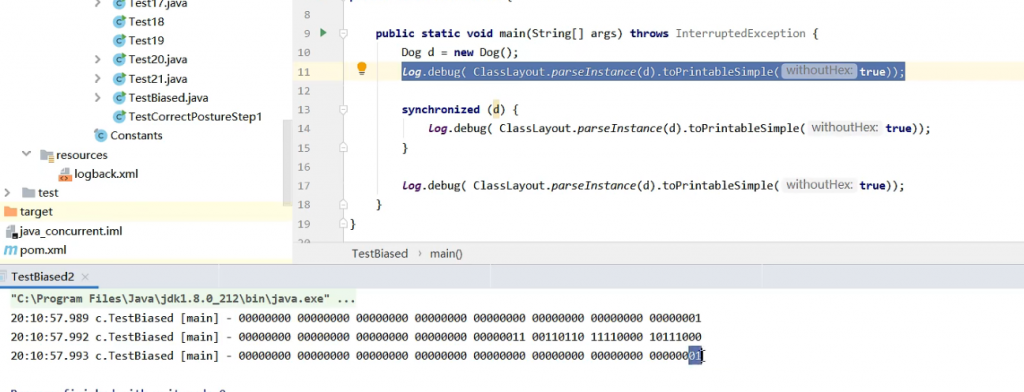



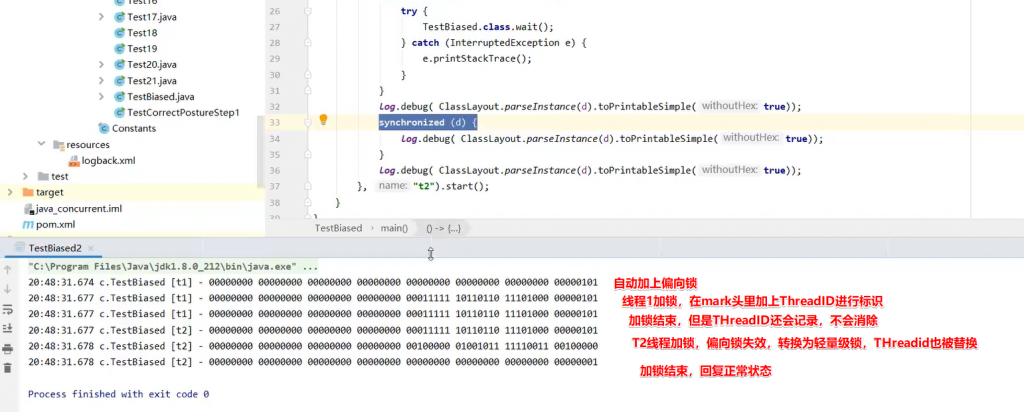
批量重偏向
如果对象虽然被多个线程访问,但没有竞争,这时偏向了线程 T1 的对象仍有机会重新偏向 T2,重偏向会重置对象
的 Thread ID
当撤销偏向锁阈值超过 20 次后,jvm 会这样觉得,我是不是偏向错了呢,于是会在给这些对象加锁时重新偏向至
加锁线程

输出结果:
[t1] - 0 00000000 00000000 00000000 00000000 00011111 11110011 11100000 00000101
[t1] - 1 00000000 00000000 00000000 00000000 00011111 11110011 11100000 00000101
[t1] - 2 00000000 00000000 00000000 00000000 00011111 11110011 11100000 00000101
[t1] - 3 00000000 00000000 00000000 00000000 00011111 11110011 11100000 00000101
[t1] - 4 00000000 00000000 00000000 00000000 00011111 11110011 11100000 00000101
[t1] - 5 00000000 00000000 00000000 00000000 00011111 11110011 11100000 00000101
[t1] - 6 00000000 00000000 00000000 00000000 00011111 11110011 11100000 00000101
[t1] - 7 00000000 00000000 00000000 00000000 00011111 11110011 11100000 00000101
[t1] - 8 00000000 00000000 00000000 00000000 00011111 11110011 11100000 00000101
[t1] - 9 00000000 00000000 00000000 00000000 00011111 11110011 11100000 00000101
[t1] - 10 00000000 00000000 00000000 00000000 00011111 11110011 11100000 00000101
[t1] - 11 00000000 00000000 00000000 00000000 00011111 11110011 11100000 00000101
[t1] - 12 00000000 00000000 00000000 00000000 00011111 11110011 11100000 00000101
[t1] - 13 00000000 00000000 00000000 00000000 00011111 11110011 11100000 00000101
[t1] - 14 00000000 00000000 00000000 00000000 00011111 11110011 11100000 00000101
[t1] - 15 00000000 00000000 00000000 00000000 00011111 11110011 11100000 00000101
[t1] - 16 00000000 00000000 00000000 00000000 00011111 11110011 11100000 00000101
[t1] - 17 00000000 00000000 00000000 00000000 00011111 11110011 11100000 00000101
[t1] - 18 00000000 00000000 00000000 00000000 00011111 11110011 11100000 00000101
[t1] - 19 00000000 00000000 00000000 00000000 00011111 11110011 11100000 00000101
[t1] - 20 00000000 00000000 00000000 00000000 00011111 11110011 11100000 00000101
[t1] - 21 00000000 00000000 00000000 00000000 00011111 11110011 11100000 00000101
[t1] - 22 00000000 00000000 00000000 00000000 00011111 11110011 11100000 00000101
[t1] - 23 00000000 00000000 00000000 00000000 00011111 11110011 11100000 00000101
[t1] - 24 00000000 00000000 00000000 00000000 00011111 11110011 11100000 00000101
[t1] - 25 00000000 00000000 00000000 00000000 00011111 11110011 11100000 00000101
[t1] - 26 00000000 00000000 00000000 00000000 00011111 11110011 11100000 00000101
[t1] - 27 00000000 00000000 00000000 00000000 00011111 11110011 11100000 00000101
[t1] - 28 00000000 00000000 00000000 00000000 00011111 11110011 11100000 00000101
[t1] - 29 00000000 00000000 00000000 00000000 00011111 11110011 11100000 00000101
[t2] - ===============>
[t2] - 0 00000000 00000000 00000000 00000000 00011111 11110011 11100000 00000101
[t2] - 0 00000000 00000000 00000000 00000000 00100000 01011000 11110111 00000000
[t2] - 0 00000000 00000000 00000000 00000000 00000000 00000000 00000000 00000001
[t2] - 1 00000000 00000000 00000000 00000000 00011111 11110011 11100000 00000101
[t2] - 1 00000000 00000000 00000000 00000000 00100000 01011000 11110111 00000000
[t2] - 1 00000000 00000000 00000000 00000000 00000000 00000000 00000000 00000001
[t2] - 2 00000000 00000000 00000000 00000000 00011111 11110011 11100000 00000101
[t2] - 2 00000000 00000000 00000000 00000000 00100000 01011000 11110111 00000000
[t2] - 2 00000000 00000000 00000000 00000000 00000000 00000000 00000000 00000001
[t2] - 3 00000000 00000000 00000000 00000000 00011111 11110011 11100000 00000101
[t2] - 3 00000000 00000000 00000000 00000000 00100000 01011000 11110111 00000000
[t2] - 3 00000000 00000000 00000000 00000000 00000000 00000000 00000000 00000001
[t2] - 4 00000000 00000000 00000000 00000000 00011111 11110011 11100000 00000101
[t2] - 4 00000000 00000000 00000000 00000000 00100000 01011000 11110111 00000000
[t2] - 4 00000000 00000000 00000000 00000000 00000000 00000000 00000000 00000001
[t2] - 5 00000000 00000000 00000000 00000000 00011111 11110011 11100000 00000101
[t2] - 5 00000000 00000000 00000000 00000000 00100000 01011000 11110111 00000000
[t2] - 5 00000000 00000000 00000000 00000000 00000000 00000000 00000000 00000001
[t2] - 6 00000000 00000000 00000000 00000000 00011111 11110011 11100000 00000101
[t2] - 6 00000000 00000000 00000000 00000000 00100000 01011000 11110111 00000000
[t2] - 6 00000000 00000000 00000000 00000000 00000000 00000000 00000000 00000001
[t2] - 7 00000000 00000000 00000000 00000000 00011111 11110011 11100000 00000101
[t2] - 7 00000000 00000000 00000000 00000000 00100000 01011000 11110111 00000000
[t2] - 7 00000000 00000000 00000000 00000000 00000000 00000000 00000000 00000001
[t2] - 8 00000000 00000000 00000000 00000000 00011111 11110011 11100000 00000101
[t2] - 8 00000000 00000000 00000000 00000000 00100000 01011000 11110111 00000000
[t2] - 8 00000000 00000000 00000000 00000000 00000000 00000000 00000000 00000001
[t2] - 9 00000000 00000000 00000000 00000000 00011111 11110011 11100000 00000101
[t2] - 9 00000000 00000000 00000000 00000000 00100000 01011000 11110111 00000000
[t2] - 9 00000000 00000000 00000000 00000000 00000000 00000000 00000000 00000001
[t2] - 10 00000000 00000000 00000000 00000000 00011111 11110011 11100000 00000101
[t2] - 10 00000000 00000000 00000000 00000000 00100000 01011000 11110111 00000000
[t2] - 10 00000000 00000000 00000000 00000000 00000000 00000000 00000000 00000001
[t2] - 11 00000000 00000000 00000000 00000000 00011111 11110011 11100000 00000101
[t2] - 11 00000000 00000000 00000000 00000000 00100000 01011000 11110111 00000000
[t2] - 11 00000000 00000000 00000000 00000000 00000000 00000000 00000000 00000001
[t2] - 12 00000000 00000000 00000000 00000000 00011111 11110011 11100000 00000101
[t2] - 12 00000000 00000000 00000000 00000000 00100000 01011000 11110111 00000000
[t2] - 12 00000000 00000000 00000000 00000000 00000000 00000000 00000000 00000001
[t2] - 13 00000000 00000000 00000000 00000000 00011111 11110011 11100000 00000101
[t2] - 13 00000000 00000000 00000000 00000000 00100000 01011000 11110111 00000000
[t2] - 13 00000000 00000000 00000000 00000000 00000000 00000000 00000000 00000001
[t2] - 14 00000000 00000000 00000000 00000000 00011111 11110011 11100000 00000101
[t2] - 14 00000000 00000000 00000000 00000000 00100000 01011000 11110111 00000000
[t2] - 14 00000000 00000000 00000000 00000000 00000000 00000000 00000000 00000001
[t2] - 15 00000000 00000000 00000000 00000000 00011111 11110011 11100000 00000101
[t2] - 15 00000000 00000000 00000000 00000000 00100000 01011000 11110111 00000000
[t2] - 15 00000000 00000000 00000000 00000000 00000000 00000000 00000000 00000001
[t2] - 16 00000000 00000000 00000000 00000000 00011111 11110011 11100000 00000101
[t2] - 16 00000000 00000000 00000000 00000000 00100000 01011000 11110111 00000000
[t2] - 16 00000000 00000000 00000000 00000000 00000000 00000000 00000000 00000001
[t2] - 17 00000000 00000000 00000000 00000000 00011111 11110011 11100000 00000101
[t2] - 17 00000000 00000000 00000000 00000000 00100000 01011000 11110111 00000000
[t2] - 17 00000000 00000000 00000000 00000000 00000000 00000000 00000000 00000001
[t2] - 18 00000000 00000000 00000000 00000000 00011111 11110011 11100000 00000101
[t2] - 18 00000000 00000000 00000000 00000000 00100000 01011000 11110111 00000000
[t2] - 18 00000000 00000000 00000000 00000000 00000000 00000000 00000000 00000001
[t2] - 19 00000000 00000000 00000000 00000000 00011111 11110011 11100000 00000101
[t2] - 19 00000000 00000000 00000000 00000000 00011111 11110011 11110001 00000101
[t2] - 19 00000000 00000000 00000000 00000000 00011111 11110011 11110001 00000101
[t2] - 20 00000000 00000000 00000000 00000000 00011111 11110011 11100000 00000101
[t2] - 20 00000000 00000000 00000000 00000000 00011111 11110011 11110001 00000101
[t2] - 20 00000000 00000000 00000000 00000000 00011111 11110011 11110001 00000101
[t2] - 21 00000000 00000000 00000000 00000000 00011111 11110011 11100000 00000101
[t2] - 21 00000000 00000000 00000000 00000000 00011111 11110011 11110001 00000101
[t2] - 21 00000000 00000000 00000000 00000000 00011111 11110011 11110001 00000101
[t2] - 22 00000000 00000000 00000000 00000000 00011111 11110011 11100000 00000101
[t2] - 22 00000000 00000000 00000000 00000000 00011111 11110011 11110001 00000101
[t2] - 22 00000000 00000000 00000000 00000000 00011111 11110011 11110001 00000101
[t2] - 23 00000000 00000000 00000000 00000000 00011111 11110011 11100000 00000101
[t2] - 23 00000000 00000000 00000000 00000000 00011111 11110011 11110001 00000101
[t2] - 23 00000000 00000000 00000000 00000000 00011111 11110011 11110001 00000101
[t2] - 24 00000000 00000000 00000000 00000000 00011111 11110011 11100000 00000101
[t2] - 24 00000000 00000000 00000000 00000000 00011111 11110011 11110001 00000101
[t2] - 24 00000000 00000000 00000000 00000000 00011111 11110011 11110001 00000101
[t2] - 25 00000000 00000000 00000000 00000000 00011111 11110011 11100000 00000101
[t2] - 25 00000000 00000000 00000000 00000000 00011111 11110011 11110001 00000101
[t2] - 25 00000000 00000000 00000000 00000000 00011111 11110011 11110001 00000101
[t2] - 26 00000000 00000000 00000000 00000000 00011111 11110011 11100000 00000101
[t2] - 26 00000000 00000000 00000000 00000000 00011111 11110011 11110001 00000101
[t2] - 26 00000000 00000000 00000000 00000000 00011111 11110011 11110001 00000101
[t2] - 27 00000000 00000000 00000000 00000000 00011111 11110011 11100000 00000101
[t2] - 27 00000000 00000000 00000000 00000000 00011111 11110011 11110001 00000101
[t2] - 27 00000000 00000000 00000000 00000000 00011111 11110011 11110001 00000101
[t2] - 28 00000000 00000000 00000000 00000000 00011111 11110011 11100000 00000101
[t2] - 28 00000000 00000000 00000000 00000000 00011111 11110011 11110001 00000101
[t2] - 28 00000000 00000000 00000000 00000000 00011111 11110011 11110001 00000101
[t2] - 29 00000000 00000000 00000000 00000000 00011111 11110011 11100000 00000101
[t2] - 29 00000000 00000000 00000000 00000000 00011111 11110011 11110001 00000101
[t2] - 29 00000000 00000000 00000000 00000000 00011111 11110011 11110001 00000101一批对象的偏向锁锁住的线程id是相同的时候,对他们进行修改的次数超过20 ,那么自21以后,原来那一批对象的偏向锁会自动的偏向之前修改的线程id
批量撤销

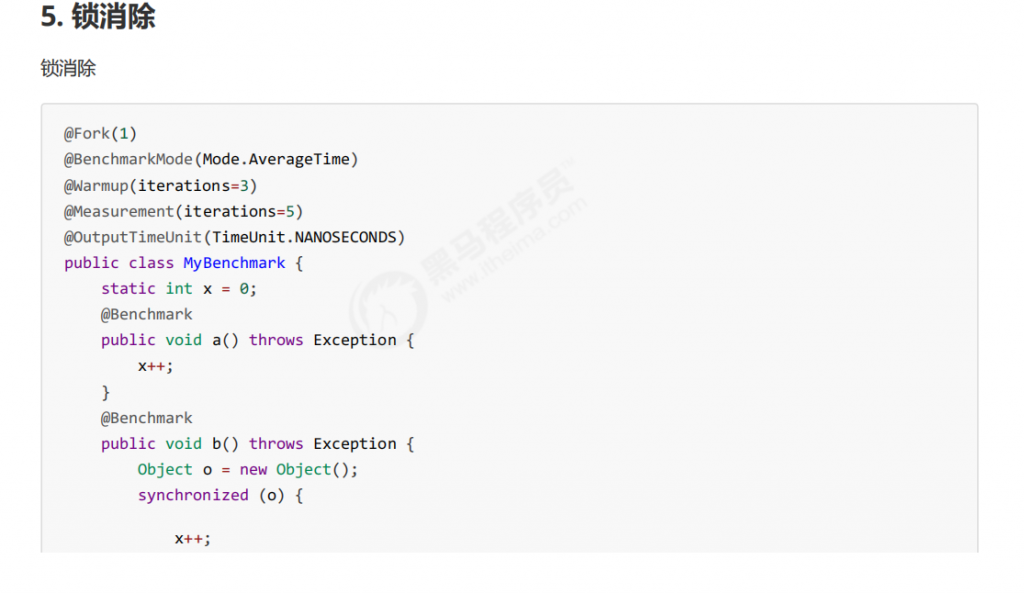
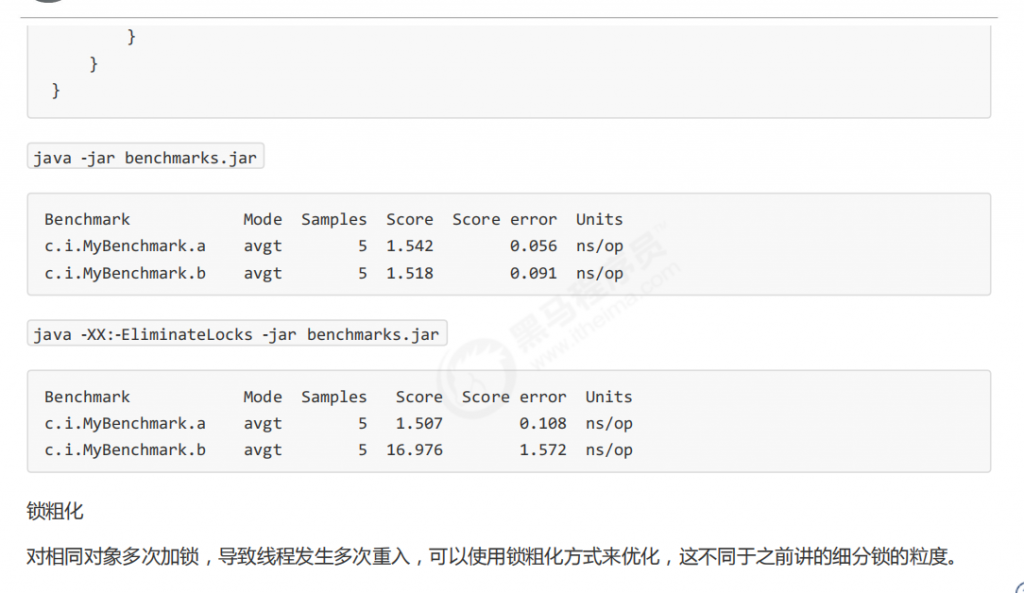
4.7 wait notify

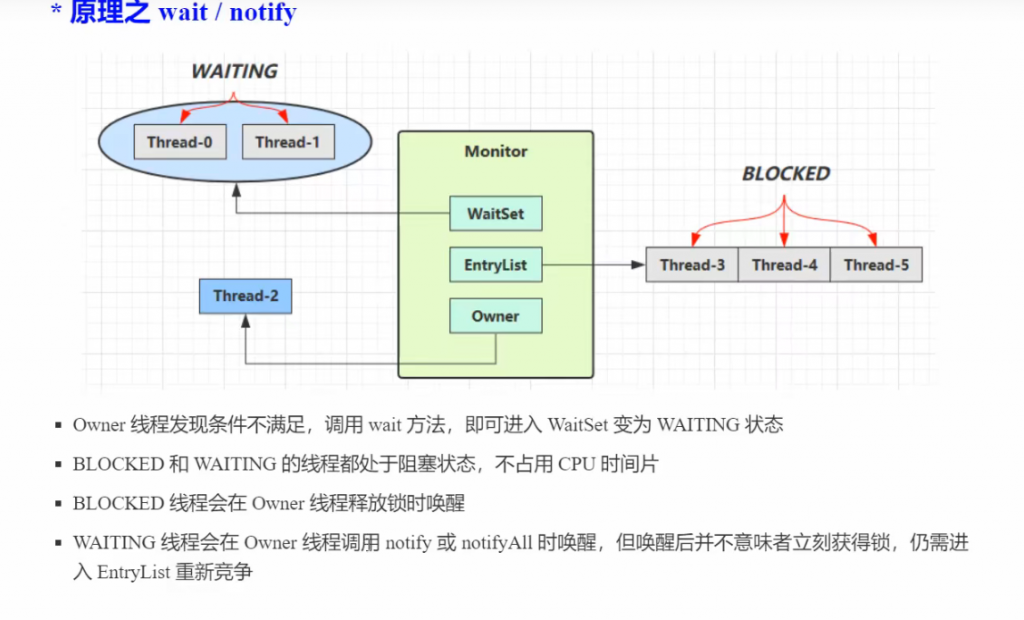


@Slf4j
public class Test22 {
static final Object lock = new Object();
public static void main(String[] args) throws InterruptedException {
new Thread(()->{
synchronized (lock){
log.debug("执行wait");
try {
lock.wait();
} catch (InterruptedException e) {
e.printStackTrace();
}
log.debug("其他的代码");
}
},"t1").start();
new Thread(()->{
synchronized (lock){
log.debug("执行wait");
try {
lock.wait();
} catch (InterruptedException e) {
e.printStackTrace();
}
log.debug("其他的代码");
}
},"t2").start();
Thread.sleep(2000);
log.debug("唤醒lock上其他线程");
synchronized (lock){
// lock.notify(); //唤醒lock上一个线程
lock.notifyAll();//唤醒lock上所有的线程
}
}
}
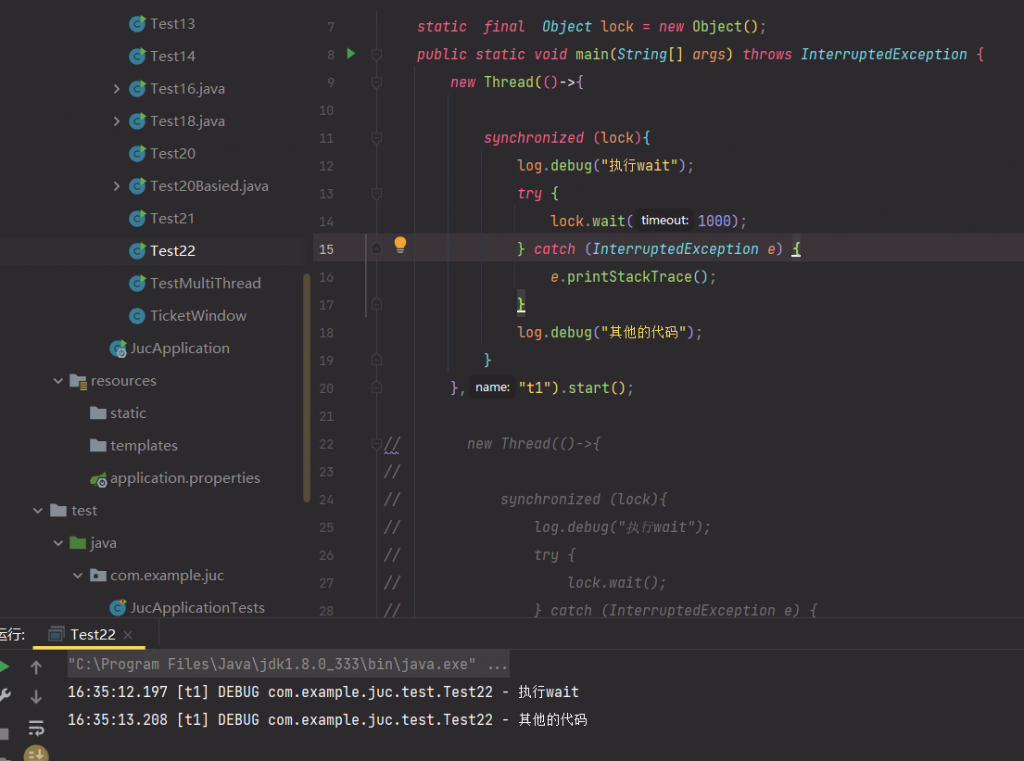
wait和sleep的区别,wait会释放锁,sleep则不会

具体代码
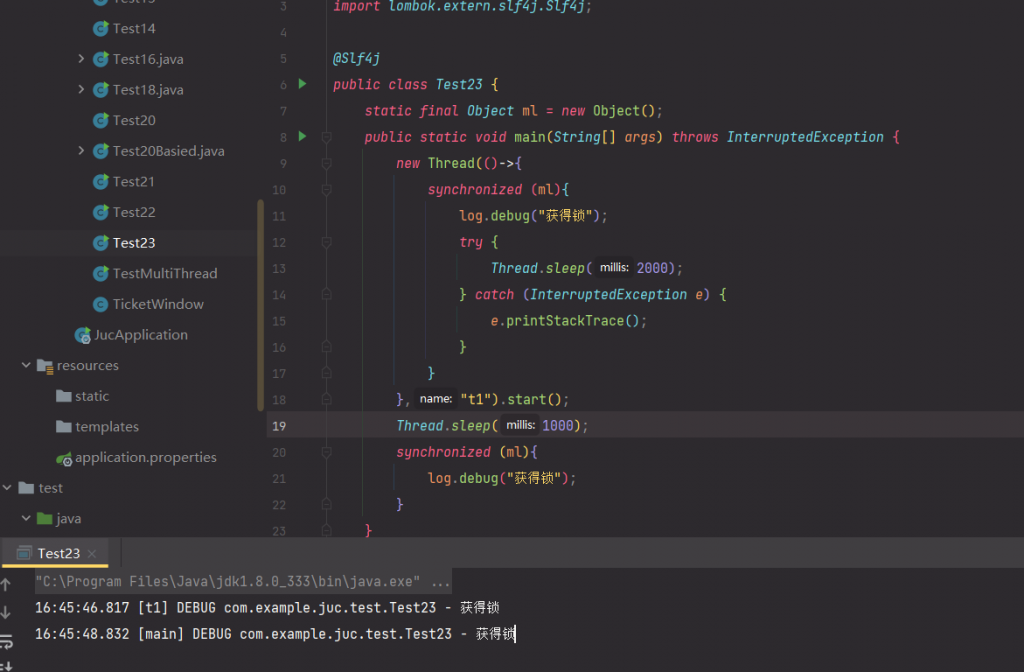
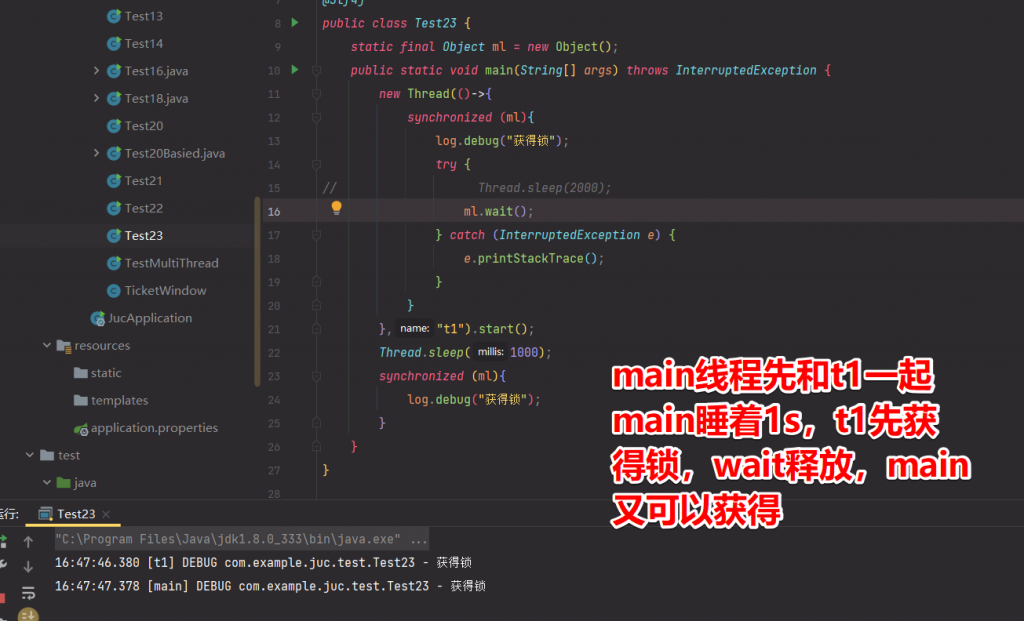

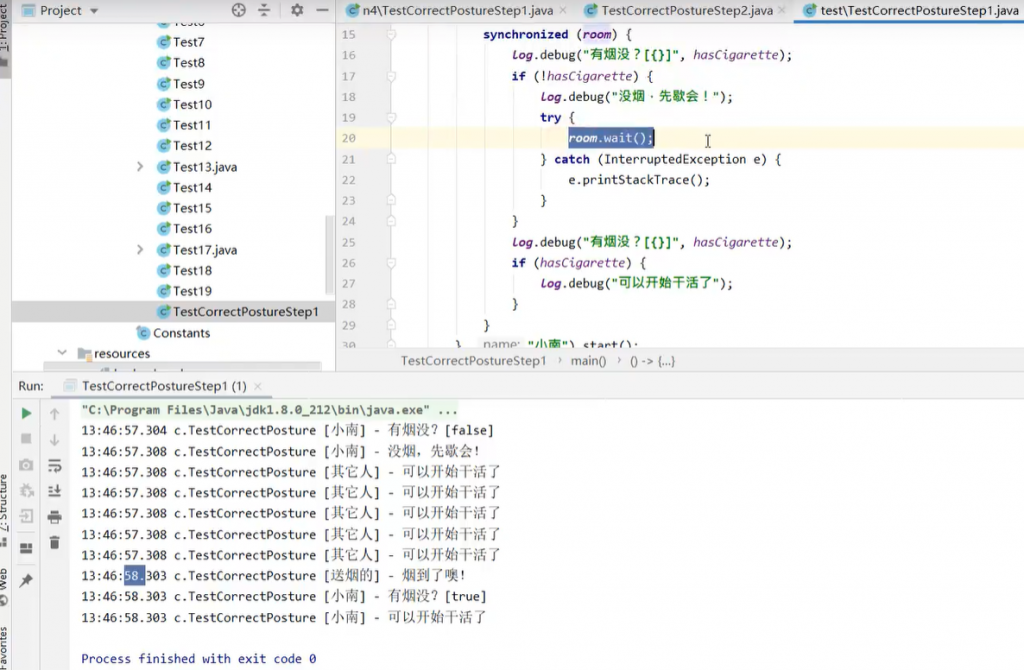
思考:要是还有其他线程呢,会不会叫错了:
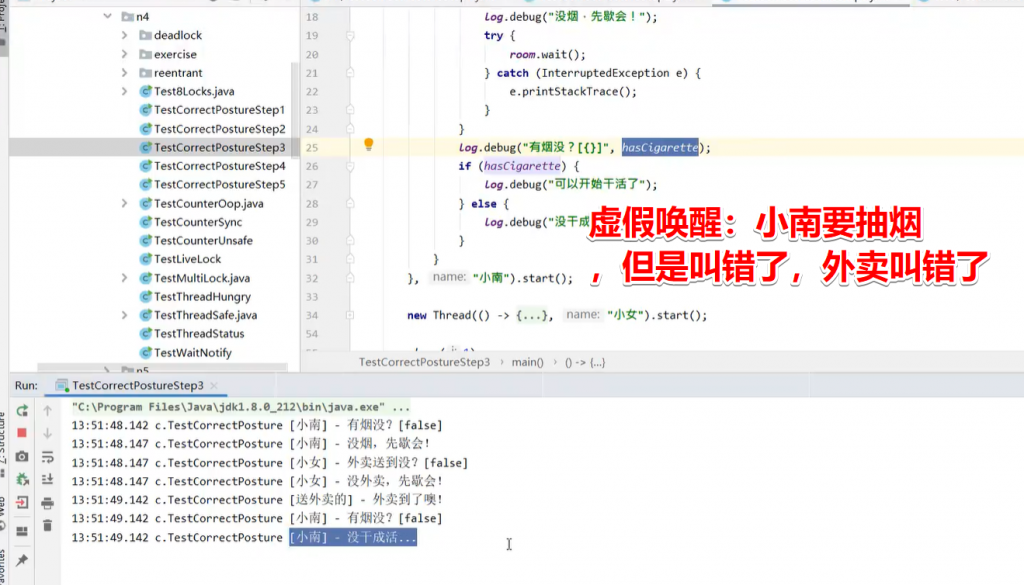
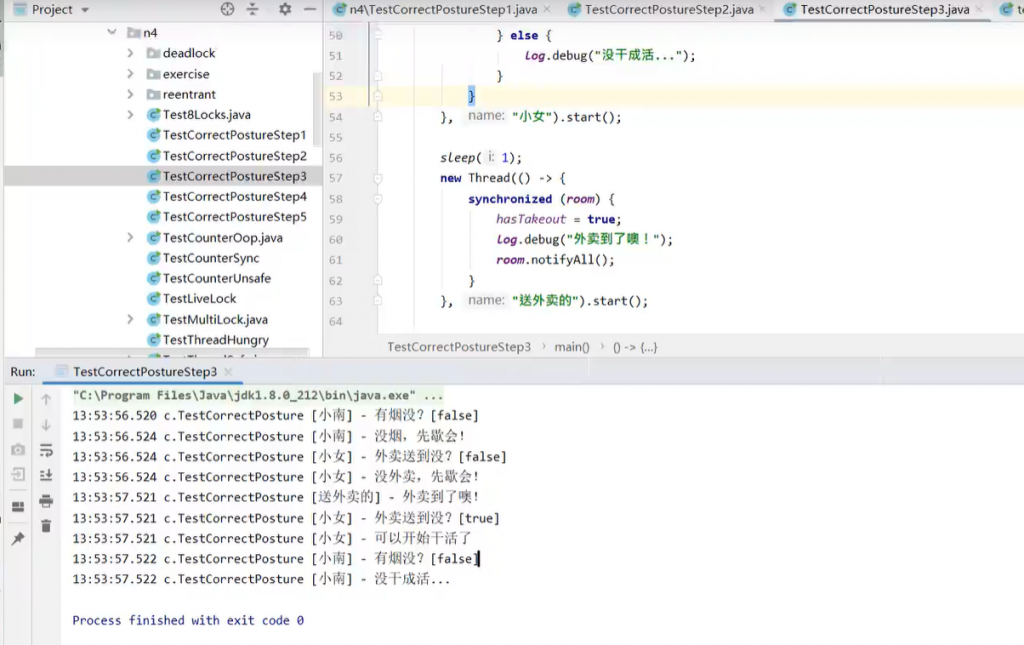
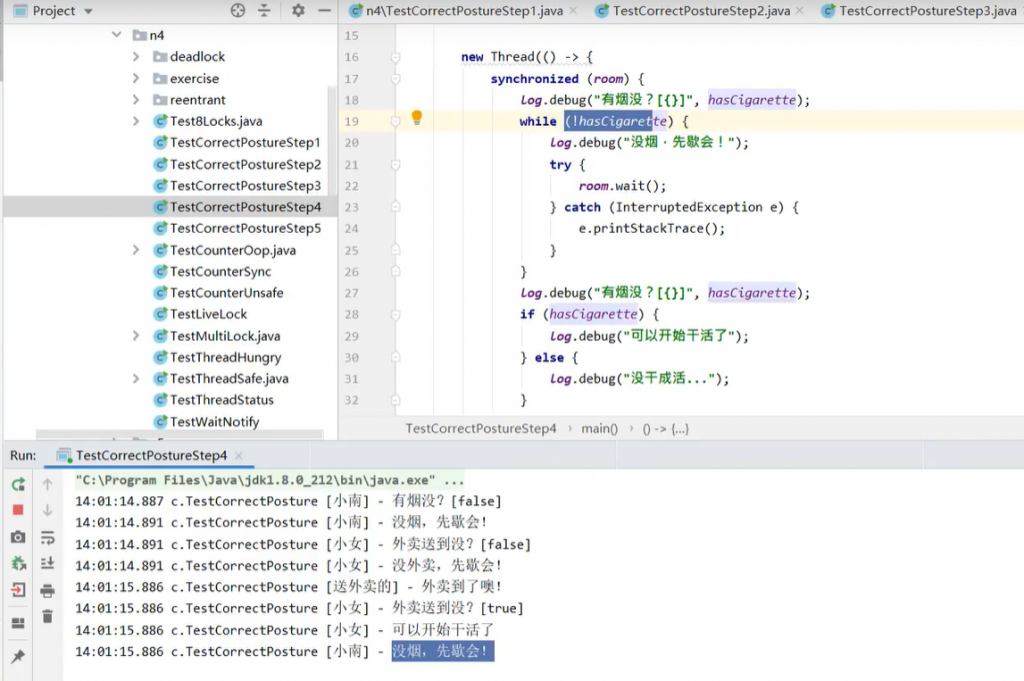

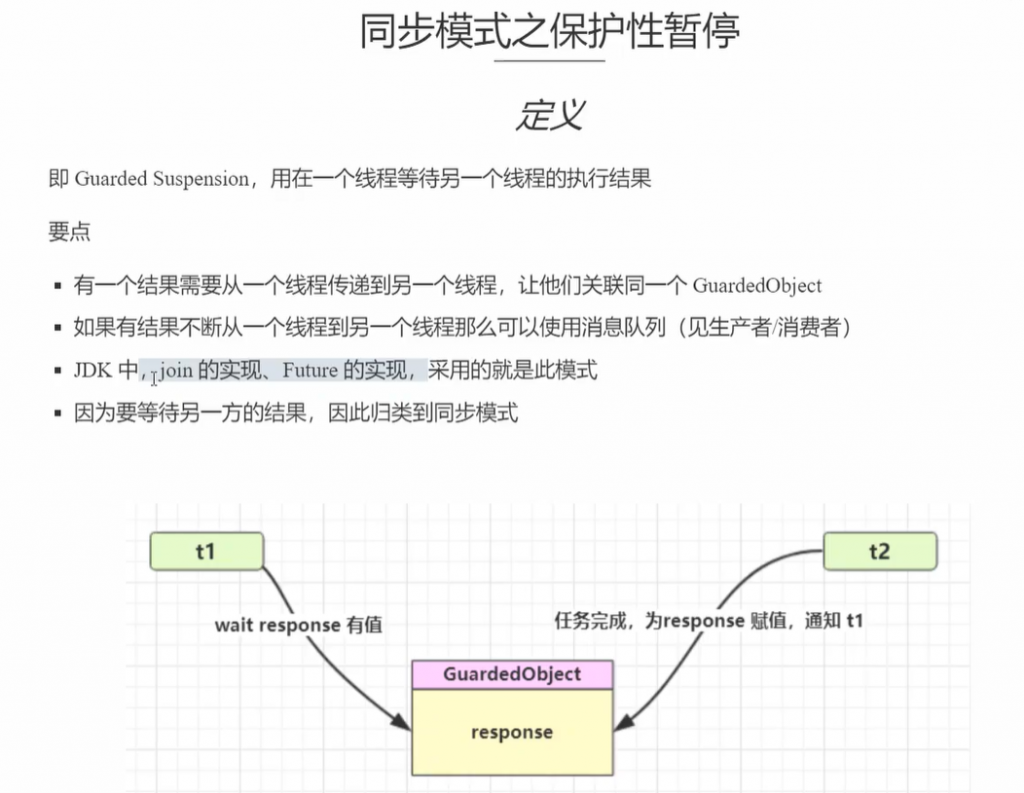
@Slf4j
public class Test1111 {
//线程1等待线程2的下载结果
public static void main(String[] args) {
GuardedObject guardedObject = new GuardedObject();
new Thread(()->{
//等待结果
log.debug("等待结果");
Vector<String> list1 = (Vector<String>)guardedObject.get();
log.debug("结果",list1.size());
},"t1").start();
new Thread(()->{
log.debug("执行代码");
Vector<String> strings = new Vector<>();
strings.add("yxx");
try {
Thread.sleep(2000);
} catch (InterruptedException e) {
e.printStackTrace();
}
guardedObject.complete(strings);
},"t2").start();
}
}
class GuardedObject{
//结果
private Object response;
//获取结果:
public Object get(){
synchronized (this){
while( response == null){
try {
this.wait();
} catch (InterruptedException e) {
e.printStackTrace();
}
}
}
return response;
}
//产生结果:
public void complete(Object response){
//给结果成员变量赋值
synchronized (this){
this.response =response;
this.notifyAll();
}
}
}
和join的区别,join必须等待一个线程结束了才能执行,但是这个模式不需要等待整个线程结束,而是只等待一部分代码
进一步优化:
class GuardedObject{
//结果
private Object response;
//获取结果:
public Object get(long timeout){
long begin = System.currentTimeMillis();
//经理时间:
long passedTime = 0;
synchronized (this){
while( response == null){
long waitTime =timeout - passedTime;
if(passedTime >= timeout){
break;
//经历的时间大于最大等待时间,退出循环;
}
try {
this.wait(waitTime);//虚假唤醒
} catch (InterruptedException e) {
e.printStackTrace();
}
//求得经历时间
passedTime = System.currentTimeMillis()-begin;
}
}
return response;
}
//产生结果:
public void complete(Object response){
//给结果成员变量赋值
synchronized (this){
this.response =response;
this.notifyAll();
}
}
}改进后的测试代码:
@Slf4j
public class Test1111 {
//线程1等待线程2的下载结果
public static void main(String[] args) {
GuardedObject guardedObject = new GuardedObject();
new Thread(() -> {
log.debug("begin");
Object resp = guardedObject.get(2000);
log.debug("结果是:{}", resp);
}, "t1").start();
new Thread(() -> {
log.debug("begin");
try {
Thread.sleep(1000);
} catch (InterruptedException e) {
e.printStackTrace();
}
guardedObject.complete(null);
}, "t2").start();
}
static class GuardedObject {
//结果
private Object response;
//获取结果:
public Object get(long timeout) {
long begin = System.currentTimeMillis();
//经理时间:
long passedTime = 0;
synchronized (this) {
while (response == null) {
long waitTime = timeout - passedTime;
if (passedTime >= timeout) {
break;
//经历的时间大于最大等待时间,退出循环;
}
try {
this.wait(waitTime);//虚假唤醒
} catch (InterruptedException e) {
e.printStackTrace();
}
//求得经历时间
passedTime = System.currentTimeMillis() - begin;
}
}
return response;
}
//产生结果:
public void complete(Object response) {
//给结果成员变量赋值
synchronized (this) {
this.response = response;
this.notifyAll();
}
}
}
}

@Slf4j(topic = "c.Test20")
public class Test1111 {
public static void main(String[] args) throws InterruptedException {
for (int i = 0; i < 3; i++) {
new People().start();
}
Thread.sleep(1000);
for (Integer id : Mailboxes.getIds()) {
new Postman(id, "内容" + id).start();
}
}
}
@Slf4j(topic = "c.People")
class People extends Thread{
@Override
public void run() {
// 收信
GuardedObject guardedObject = Mailboxes.createGuardedObject();
log.debug("开始收信 id:{}", guardedObject.getId());
Object mail = guardedObject.get(5000);
log.debug("收到信 id:{}, 内容:{}", guardedObject.getId(), mail);
}
}
@Slf4j(topic = "c.Postman")
class Postman extends Thread {
private int id;
private String mail;
public Postman(int id, String mail) {
this.id = id;
this.mail = mail;
}
@Override
public void run() {
GuardedObject guardedObject = Mailboxes.getGuardedObject(id);
log.debug("送信 id:{}, 内容:{}", id, mail);
guardedObject.complete(mail);
}
}
class Mailboxes {
private static Map<Integer, GuardedObject> boxes = new Hashtable<>();
private static int id = 1;
// 产生唯一 id
private static synchronized int generateId() {
return id++;
}
public static GuardedObject getGuardedObject(int id) {
return boxes.remove(id);
}
public static GuardedObject createGuardedObject() {
GuardedObject go = new GuardedObject(generateId());
boxes.put(go.getId(), go);
return go;
}
public static Set<Integer> getIds() {
return boxes.keySet();
}
}
// 增加超时效果
class GuardedObject {
// 标识 Guarded Object
private int id;
public GuardedObject(int id) {
this.id = id;
}
public int getId() {
return id;
}
// 结果
private Object response;
// 获取结果
// timeout 表示要等待多久 2000
public Object get(long timeout) {
synchronized (this) {
// 开始时间 15:00:00
long begin = System.currentTimeMillis();
// 经历的时间
long passedTime = 0;
while (response == null) {
// 这一轮循环应该等待的时间
long waitTime = timeout - passedTime;
// 经历的时间超过了最大等待时间时,退出循环
if (timeout - passedTime <= 0) {
break;
}
try {
this.wait(waitTime); // 虚假唤醒 15:00:01
} catch (InterruptedException e) {
e.printStackTrace();
}
// 求得经历时间
passedTime = System.currentTimeMillis() - begin; // 15:00:02 1s
}
return response;
}
}
// 产生结果
public void complete(Object response) {
synchronized (this) {
// 给结果成员变量赋值
this.response = response;
this.notifyAll();
}
}
}
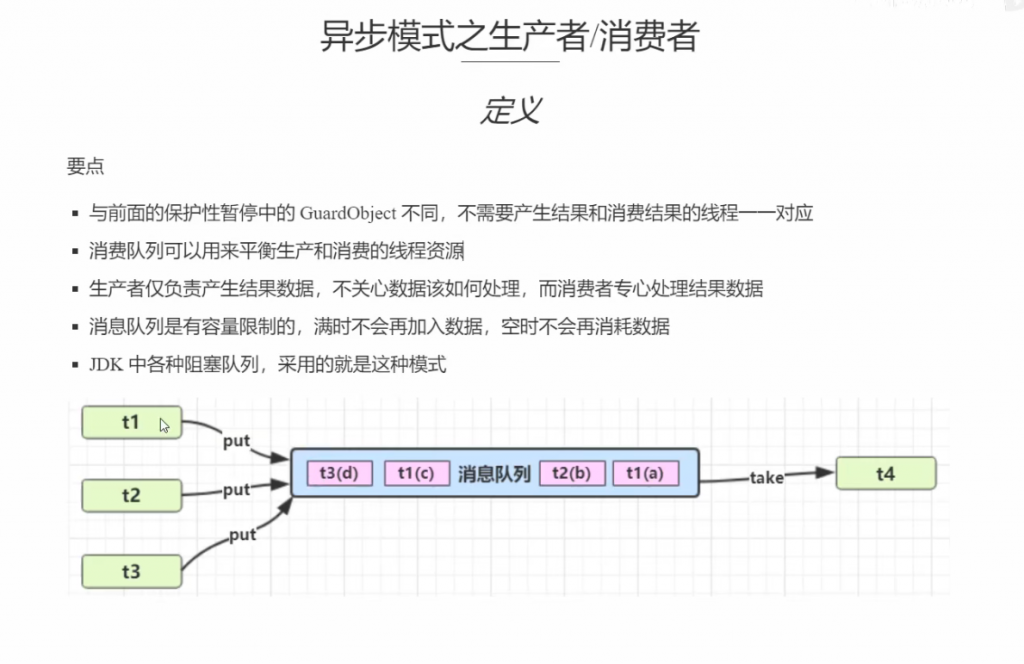
package com.example.juc.test;
import lombok.extern.slf4j.Slf4j;
import java.util.LinkedList;
@Slf4j(topic = "c.Test21")
public class Test24 {
public static void main(String[] args) {
MessageQueue queue = new MessageQueue(2);
for (int i = 0; i < 3; i++) {
int id = i;
new Thread(() -> {
queue.put(new Message(id , "值"+id));
}, "生产者" + i).start();
}
new Thread(() -> {
while(true) {
try {
Thread.sleep(1000);
} catch (InterruptedException e) {
e.printStackTrace();
}
Message message = queue.take();
}
}, "消费者").start();
}
}
// 消息队列类 , java 线程之间通信
@Slf4j(topic = "c.MessageQueue")
class MessageQueue {
// 消息的队列集合
private LinkedList<Message> list = new LinkedList<>();
// 队列容量
private int capcity;
public MessageQueue(int capcity) {
this.capcity = capcity;
}
// 获取消息
public Message take() {
// 检查队列是否为空
synchronized (list) {
while(list.isEmpty()) {
try {
log.debug("队列为空, 消费者线程等待");
list.wait();
} catch (InterruptedException e) {
e.printStackTrace();
}
}
// 从队列头部获取消息并返回
Message message = list.removeFirst();
log.debug("已消费消息 {}", message);
list.notifyAll();
return message;
}
}
// 存入消息
public void put(Message message) {
synchronized (list) {
// 检查对象是否已满
while(list.size() == capcity) {
try {
log.debug("队列已满, 生产者线程等待");
list.wait();
} catch (InterruptedException e) {
e.printStackTrace();
}
}
// 将消息加入队列尾部
list.addLast(message);
log.debug("已生产消息 {}", message);
list.notifyAll();
}
}
}
final class Message {
private int id;
private Object value;
public Message(int id, Object value) {
this.id = id;
this.value = value;
}
public int getId() {
return id;
}
public Object getValue() {
return value;
}
@Override
public String toString() {
return "Message{" +
"id=" + id +
", value=" + value +
'}';
}
}
Park & unpark
package com.example.juc.test;
import lombok.extern.slf4j.Slf4j;
import java.util.concurrent.locks.LockSupport;
@Slf4j
public class Test25 {
public static void main(String[] args) throws InterruptedException {
Thread t1 = new Thread(() -> {
log.debug("start.....");
try {
Thread.sleep(1000);
} catch (InterruptedException e) {
e.printStackTrace();
}
log.debug("park");
LockSupport.park();
log.debug("resume....");
}, "t1");
t1.start();
Thread.sleep(2000);
log.debug("unpark....");
LockSupport.unpark(t1);
}
}


特点
与 Object 的 wait & notify 相比
1.wait,notify 和 notifyAll 必须配合 Object Monitor 一起使用,而 park,unpark 不必
2.park & unpark 是以线程为单位来【阻塞】和【唤醒】线程,而 notify 只能随机唤醒一个等待线程,notifyAll
是唤醒所有等待线程,就不那么【精确】
3.park & unpark 可以先 unpark,而 wait & notify 不能先 notify

原理:
每个线程都有自己的一个 Parker 对象,由三部分组成 _counter , _cond 和 _mutex 打个比喻
线程就像一个旅人,Parker 就像他随身携带的背包,条件变量就好比背包中的帐篷。_counter 就好比背包中
的备用干粮(0 为耗尽,1 为充足)
调用 park 就是要看需不需要停下来歇息
如果备用干粮耗尽,那么钻进帐篷歇息
如果备用干粮充足,那么不需停留,继续前进
调用 unpark,就好比令干粮充足
如果这时线程还在帐篷,就唤醒让他继续前进
如果这时线程还在运行,那么下次他调用 park 时,仅是消耗掉备用干粮,不需停留继续前进
因为背包空间有限,多次调用 unpark 仅会补充一份备用干粮



4.10 重新理解线程状态转换

假设有线程 Thread t
情况 1 NEW —> RUNNABLE
当调用 t.start() 方法时,由 NEW –> RUNNABLE
情况 2 RUNNABLE <—> WAITING
t 线程用 synchronized(obj) 获取了对象锁后
调用 obj.wait() 方法时,t 线程从 RUNNABLE –> WAITING
调用 obj.notify() , obj.notifyAll() , t.interrupt() 时
竞争锁成功,t 线程从 WAITING –> RUNNABLE
竞争锁失败,t 线程从 WAITING –> BLOCKED
public class TestWaitNotify {
final static Object obj = new Object();
public static void main(String[] args) {
new Thread(() -> {
synchronized (obj) {
log.debug("执行....");
try {
obj.wait();
} catch (InterruptedException e) {
e.printStackTrace();
}
log.debug("其它代码...."); // 断点
}
},"t1").start();
new Thread(() -> {
synchronized (obj) {
log.debug("执行....");
try {
obj.wait();
} catch (InterruptedException e) {
e.printStackTrace();
}
log.debug("其它代码...."); // 断点
}
},"t2").start();
sleep(0.5);
log.debug("唤醒 obj 上其它线程");
synchronized (obj) {
obj.notifyAll(); // 唤醒obj上所有等待线程 断点
}
}
}情况 3 RUNNABLE <—> WAITING
当前线程调用 t.join() 方法时,当前线程从 RUNNABLE –> WAITING
注意是当前线程在t 线程对象的监视器上等待
t 线程运行结束,或调用了当前线程的 interrupt() 时,当前线程从 WAITING –> RUNNABLE
情况 4 RUNNABLE <—> WAITING
当前线程调用 LockSupport.park() 方法会让当前线程从 RUNNABLE –> WAITING
调用 LockSupport.unpark(目标线程) 或调用了线程 的 interrupt() ,会让目标线程从 WAITING –>
RUNNABLE
情况 5 RUNNABLE <–> TIMED_WAITING
t 线程用 synchronized(obj) 获取了对象锁后
调用 obj.wait(long n) 方法时,t 线程从 RUNNABLE –> TIMED_WAITING
t 线程等待时间超过了 n 毫秒,或调用 obj.notify() , obj.notifyAll() , t.interrupt() 时
竞争锁成功,t 线程从 TIMED_WAITING –> RUNNABLE
竞争锁失败,t 线程从 TIMED_WAITING –> BLOCKED
情况 6 RUNNABLE <—> TIMED_WAITING
当前线程调用 t.join(long n) 方法时,当前线程从 RUNNABLE –> TIMED_WAITING
注意是当前线程在t 线程对象的监视器上等待
当前线程等待时间超过了 n 毫秒,或t 线程运行结束,或调用了当前线程的 interrupt() 时,当前线程从
TIMED_WAITING –> RUNNABLE
情况 7 RUNNABLE <—> TIMED_WAITING
当前线程调用 Thread.sleep(long n) ,当前线程从 RUNNABLE –> TIMED_WAITING
当前线程等待时间超过了 n 毫秒,当前线程从 TIMED_WAITING –> RUNNABLE
情况 8 RUNNABLE <—> TIMED_WAITING
当前线程调用 LockSupport.parkNanos(long nanos) 或 LockSupport.parkUntil(long millis) 时,当前线
程从 RUNNABLE –> TIMED_WAITING
调用 LockSupport.unpark(目标线程) 或调用了线程 的 interrupt() ,或是等待超时,会让目标线程从
TIMED_WAITING–> RUNNABLE
情况 9 RUNNABLE <—> BLOCKED
t 线程用 synchronized(obj) 获取了对象锁时如果竞争失败,从 RUNNABLE –> BLOCKED
持 obj 锁线程的同步代码块执行完毕,会唤醒该对象上所有 BLOCKED 的线程重新竞争,如果其中 t 线程竞争
成功,从 BLOCKED –> RUNNABLE ,其它失败的线程仍然 BLOCKED
情况 10 RUNNABLE <—> TERMINATED
当前线程所有代码运行完毕,进入 TERMINATED
4.11 多把锁
多把不相干的锁
一间大屋子有两个功能:睡觉、学习,互不相干。
现在小南要学习,小女要睡觉,但如果只用一间屋子(一个对象锁)的话,那么并发度很低
解决方法是准备多个房间(多个对象锁)
例如
class BigRoom {
public void sleep() {
synchronized (this) {
log.debug("sleeping 2 小时");
Sleeper.sleep(2);
}
}
public void study() {
synchronized (this) {
log.debug("study 1 小时");
Sleeper.sleep(1);
}
}
}

改进
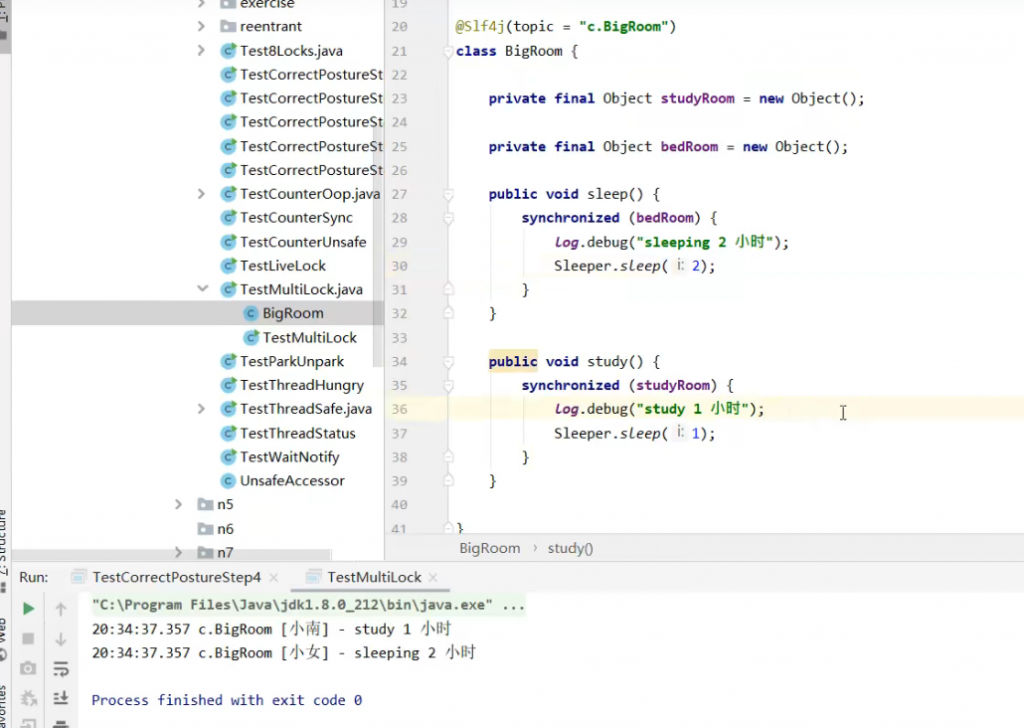



4.12 活跃性
死锁
有这样的情况:一个线程需要同时获取多把锁,这时就容易发生死锁
t1 线程 获得 A对象 锁,接下来想获取 B对象 的锁 t2 线程 获得 B对象 锁,接下来想获取 A对象 的锁 例:
Object A = new Object();
Object B = new Object();
Thread t1 = new Thread(() -> {
synchronized (A) {
log.debug("lock A");
sleep(1);
synchronized (B) {
log.debug("lock B");
log.debug("操作...");
}
}
}, "t1");
Thread t2 = new Thread(() -> {
synchronized (B) {
log.debug("lock B");
sleep(0.5);
synchronized (A) {
log.debug("lock A");
log.debug("操作...");
}
}
}, "t2");
t1.start();
t2.start();结果
12:22:06.962 [t2] c.TestDeadLock – lock B
12:22:06.962 [t1] c.TestDeadLock – lock A
定位死锁
检测死锁可以使用 jconsole工具,或者使用 jps 定位进程 id,再用 jstack 定位死锁:
cmd > jps
Picked up JAVA_TOOL_OPTIONS: -Dfile.encoding=UTF-8
12320 Jps
22816 KotlinCompileDaemon
33200 TestDeadLock // JVM 进程
11508 Main
28468 Launcher
cmd > jstack 33200
Picked up JAVA_TOOL_OPTIONS: -Dfile.encoding=UTF-8
2018-12-29 05:51:40
Full thread dump Java HotSpot(TM) 64-Bit Server VM (25.91-b14 mixed mode):
“DestroyJavaVM” #13 prio=5 os_prio=0 tid=0x0000000003525000 nid=0x2f60 waiting on condition
[0x0000000000000000]
java.lang.Thread.State: RUNNABLE
“Thread-1” #12 prio=5 os_prio=0 tid=0x000000001eb69000 nid=0xd40 waiting for monitor entry
[0x000000001f54f000]
java.lang.Thread.State: BLOCKED (on object monitor)
at thread.TestDeadLock.lambda$main$1(TestDeadLock.java:28)
– waiting to lock <0x000000076b5bf1c0> (a java.lang.Object)
– locked <0x000000076b5bf1d0> (a java.lang.Object)
at thread.TestDeadLock$$Lambda$2/883049899.run(Unknown Source)
at java.lang.Thread.run(Thread.java:745)
“Thread-0” #11 prio=5 os_prio=0 tid=0x000000001eb68800 nid=0x1b28 waiting for monitor entry
[0x000000001f44f000]
java.lang.Thread.State: BLOCKED (on object monitor)
at thread.TestDeadLock.lambda$main$0(TestDeadLock.java:15)
– waiting to lock <0x000000076b5bf1d0> (a java.lang.Object)
– locked <0x000000076b5bf1c0> (a java.lang.Object)
at thread.TestDeadLock$$Lambda$1/495053715.run(Unknown Source)
at java.lang.Thread.run(Thread.java:745)
// 略去部分输出
Found one Java-level deadlock:
=============================
“Thread-1”:
waiting to lock monitor 0x000000000361d378 (object 0x000000076b5bf1c0, a java.lang.Object),
which is held by “Thread-0”
“Thread-0”:
waiting to lock monitor 0x000000000361e768 (object 0x000000076b5bf1d0, a java.lang.Object),
which is held by “Thread-1”
Java stack information for the threads listed above:
===================================================
“Thread-1”:
at thread.TestDeadLock.lambda$main$1(TestDeadLock.java:28)
– waiting to lock <0x000000076b5bf1c0> (a java.lang.Object)
– locked <0x000000076b5bf1d0> (a java.lang.Object)
at thread.TestDeadLock$$Lambda$2/883049899.run(Unknown Source)
at java.lang.Thread.run(Thread.java:745)
“Thread-0”:
at thread.TestDeadLock.lambda$main$0(TestDeadLock.java:15)
– waiting to lock <0x000000076b5bf1d0> (a java.lang.Object)
– locked <0x000000076b5bf1c0> (a java.lang.Object)
at thread.TestDeadLock$$Lambda$1/495053715.run(Unknown Source)
at java.lang.Thread.run(Thread.java:745)
Found 1 deadlock.
避免死锁要注意加锁顺序
另外如果由于某个线程进入了死循环,导致其它线程一直等待,对于这种情况 linux 下可以通过 top 先定位到
CPU 占用高的 Java 进程,再利用 top -Hp 进程id 来定位是哪个线程,最后再用 jstack 排查
哲学家就餐问题

有五位哲学家,围坐在圆桌旁。
他们只做两件事,思考和吃饭,思考一会吃口饭,吃完饭后接着思考。
吃饭时要用两根筷子吃,桌上共有 5 根筷子,每位哲学家左右手边各有一根筷子。
如果筷子被身边的人拿着,自己就得等待
筷子类
class Chopstick {
String name;
public Chopstick(String name) {
this.name = name;
}
@Override
public String toString() {
return "筷子{" + name + '}';
}
}
哲学家类
class Philosopher extends Thread {
Chopstick left;
Chopstick right;
public Philosopher(String name, Chopstick left, Chopstick right) {
super(name);
this.left = left;
this.right = right;
}
private void eat() {
log.debug("eating...");
Sleeper.sleep(1);
}
@Override
public void run() {
while (true) {
// 获得左手筷子
synchronized (left) {
// 获得右手筷子
synchronized (right) {
// 吃饭
eat();
}
// 放下右手筷子
}
// 放下左手筷子
}
}
}就餐
Chopstick c1 = new Chopstick("1");
Chopstick c2 = new Chopstick("2");
Chopstick c3 = new Chopstick("3");
Chopstick c4 = new Chopstick("4");
Chopstick c5 = new Chopstick("5");
new Philosopher("苏格拉底", c1, c2).start();
new Philosopher("柏拉图", c2, c3).start();
new Philosopher("亚里士多德", c3, c4).start();
new Philosopher("赫拉克利特", c4, c5).start();
new Philosopher("阿基米德", c5, c1).start()执行不多会,就执行不下去了
12:33:15.575 [苏格拉底] c.Philosopher - eating...
12:33:15.575 [亚里士多德] c.Philosopher - eating...
12:33:16.580 [阿基米德] c.Philosopher - eating...
12:33:17.580 [阿基米德] c.Philosopher - eating...
// 卡在这里, 不向下运行使用 jconsole 检测死锁,发现
名称: 阿基米德
状态: cn.itcast.Chopstick@1540e19d (筷子1) 上的BLOCKED, 拥有者: 苏格拉底
总阻止数: 2, 总等待数: 1
堆栈跟踪:
cn.itcast.Philosopher.run(TestDinner.java:48)
- 已锁定 cn.itcast.Chopstick@6d6f6e28 (筷子5)
-------------------------------------------------------------------------
名称: 苏格拉底
状态: cn.itcast.Chopstick@677327b6 (筷子2) 上的BLOCKED, 拥有者: 柏拉图
总阻止数: 2, 总等待数: 1
堆栈跟踪:
cn.itcast.Philosopher.run(TestDinner.java:48)
- 已锁定 cn.itcast.Chopstick@1540e19d (筷子1)
-------------------------------------------------------------------------
名称: 柏拉图
状态: cn.itcast.Chopstick@14ae5a5 (筷子3) 上的BLOCKED, 拥有者: 亚里士多德
总阻止数: 2, 总等待数: 0
堆栈跟踪:
cn.itcast.Philosopher.run(TestDinner.java:48)
- 已锁定 cn.itcast.Chopstick@677327b6 (筷子2)
-------------------------------------------------------------------------
名称: 亚里士多德
状态: cn.itcast.Chopstick@7f31245a (筷子4) 上的BLOCKED, 拥有者: 赫拉克利特
总阻止数: 1, 总等待数: 1
堆栈跟踪:
cn.itcast.Philosopher.run(TestDinner.java:48)
- 已锁定 cn.itcast.Chopstick@14ae5a5 (筷子3)
-------------------------------------------------------------------------
名称: 赫拉克利特
状态: cn.itcast.Chopstick@6d6f6e28 (筷子5) 上的BLOCKED, 拥有者: 阿基米德
总阻止数: 2, 总等待数: 0
堆栈跟踪:
cn.itcast.Philosopher.run(TestDinner.java:48)
- 已锁定 cn.itcast.Chopstick@7f31245a (筷子4)这种线程没有按预期结束,执行不下去的情况,归类为【活跃性】问题,除了死锁以外,还有活锁和饥饿者两种情
况
活锁
活锁出现在两个线程互相改变对方的结束条件,最后谁也无法结束,例如
public class TestLiveLock {
static volatile int count = 10;
static final Object lock = new Object();
public static void main(String[] args) {
new Thread(() -> {
// 期望减到 0 退出循环
while (count > 0) {
sleep(0.2);
count--;
log.debug("count: {}", count);
}
}, "t1").start();
new Thread(() -> {
// 期望超过 20 退出循环
while (count < 20) {
sleep(0.2);
count++;
log.debug("count: {}", count);
}
}, "t2").start();
}
}饥饿
很多教程中把饥饿定义为,一个线程由于优先级太低,始终得不到 CPU 调度执行,也不能够结束,饥饿的情况不
易演示,讲读写锁时会涉及饥饿问题
下面我讲一下我遇到的一个线程饥饿的例子,先来看看使用顺序加锁的方式解决之前的死锁问题

顺序加锁的解决方案

4.13 ReentrantLock
相对于 synchronized 它具备如下特点
可中断
可以设置超时时间
可以设置为公平锁
支持多个条件变量
与 synchronized 一样,都支持可重入

可重入
可重入是指同一个线程如果首次获得了这把锁,那么因为它是这把锁的拥有者,因此有权利再次获取这把锁
如果是不可重入锁,那么第二次获得锁时,自己也会被锁挡住
package com.example.juc.test;
import lombok.extern.slf4j.Slf4j;
import java.util.concurrent.locks.ReentrantLock;
@Slf4j
public class Test26 {
private static ReentrantLock lock = new ReentrantLock();
public static void main(String[] args) {
method1();
}
private static void method1() {
lock.lock();
try {
log.debug("m1");
method2();
}finally {
lock.unlock();
}
}
private static void method2() {
lock.lock();
try {
log.debug("m2");
method3();
}finally {
lock.unlock();
}
}
private static void method3() {
lock.lock();
try {
log.debug("m3");
}finally {
lock.unlock();
}
}
}

可打断
代码
package com.example.juc.test;
import lombok.extern.slf4j.Slf4j;
import java.util.concurrent.locks.ReentrantLock;
@Slf4j
public class Test27 {
private static ReentrantLock lock = new ReentrantLock();
public static void main(String[] args) throws InterruptedException {
Thread t1 = new Thread(() -> {
log.debug("启动");
try {
lock.lockInterruptibly();
}catch (InterruptedException e){
e.printStackTrace();
log.debug("等待锁的过程中被打断了");
return;
}
try {
log.debug("获得了锁");
}finally {
lock.unlock();
}
}, "t1");
lock.lock();
log.debug("获得了锁");
t1.start();
try {
Thread.sleep(1000);
t1.interrupt();
log.debug("执行打断");
}finally {
lock.unlock();
}
}
}
package com.example.juc.test;
import lombok.extern.slf4j.Slf4j;
import java.util.concurrent.TimeUnit;
import java.util.concurrent.locks.ReentrantLock;
@Slf4j
public class Test28 {
private static ReentrantLock lock = new ReentrantLock();
public static void main(String[] args) throws InterruptedException {
Thread t1 = new Thread(() -> {
log.debug("尝试获得锁");
try {
if (!lock.tryLock(2, TimeUnit.SECONDS));
}catch (InterruptedException e){
e.printStackTrace();
log.debug("获取不到锁");
return;
}
try {
log.debug("获得到锁");
}finally {
lock.unlock();
}
},"t1");
lock.lock();
log.debug("获得到锁");
t1.start();
Thread.sleep(1000);
log.debug("释放锁");
lock.unlock();
}
}

立刻失败
公平锁
ReentrantLock 默认是不公平的
强行插入,有机会在中间输出
公平锁一般没有必要,会降低并发度,后面分析原理时会讲解
条件变量
synchronized 中也有条件变量,就是我们讲原理时那个 waitSet 休息室,当条件不满足时进入 waitSet 等待
ReentrantLock 的条件变量比 synchronized 强大之处在于,它是支持多个条件变量的,这就好比
synchronized 是那些不满足条件的线程都在一间休息室等消息
而 ReentrantLock 支持多间休息室,有专门等烟的休息室、专门等早餐的休息室、唤醒时也是按休息室来唤
醒
使用要点:
await 前需要获得锁
await 执行后,会释放锁,进入 conditionObject 等待
await 的线程被唤醒(或打断、或超时)取重新竞争 lock 锁
竞争 lock 锁成功后,从 await 后继续执行
同步模式之顺序控制
1. 固定运行顺序
比如,必须先 2 后 1 打印
1.1 wait notify 版
package com.example.juc.test;
import lombok.extern.slf4j.Slf4j;
@Slf4j
public class Test30 {
static Object object = new Object();
//标记t2是否执行过
static boolean t2runned = false;
public static void main(String[] args) {
Thread t1 = new Thread(() -> {
synchronized (object){
//如果t2没有执行过
while(!t2runned){
try {
//t1先等一会
object.wait();
}catch (InterruptedException e){
e.printStackTrace();
}
}
System.out.println(1);
}
},"t1");
Thread t2 = new Thread(() -> {
System.out.println(2);
synchronized (object){
//修改运行标记
t2runned = true;
//通知obj上等待的线程(可能有多个,因此需要用notifyall)
object.notifyAll();
}
}, "t2");
t1.start();
t2.start();
}
}

park & unpark
package com.example.juc.test;
import lombok.extern.slf4j.Slf4j;
import java.util.concurrent.locks.LockSupport;
@Slf4j
public class Test31 {
public static void main(String[] args) {
Thread t1 = new Thread(() -> {
LockSupport.park();
log.debug("1");
}, "t1");
t1.start();
new Thread(() ->{
log.debug("2");
LockSupport.unpark(t1);
},"t2").start();
}
}


package com.example.juc.test;
import lombok.extern.slf4j.Slf4j;
@Slf4j
public class Test32 {
public static void main(String[] args) {
waitNotify waitNotify = new waitNotify(1, 5);
new Thread(()->{
try {
waitNotify.print("a", 1, 2);
} catch (InterruptedException e) {
e.printStackTrace();
}
}).start();
new Thread(()->{
try {
waitNotify.print("b", 2, 3);
} catch (InterruptedException e) {
e.printStackTrace();
}
}).start();
new Thread(()->{
try {
waitNotify.print("c", 3, 1);
} catch (InterruptedException e) {
e.printStackTrace();
}
}).start();
}
}
/**
* 输出内容,等待标记 下一个标记
* a .... 1 .......... 2
* b......2 .......... 3
* c ......3 ............1
*/
class waitNotify{
//打印
public void print(String str,int waitFlag,int nextFlag) throws InterruptedException {
for (int i = 0; i < loopNumber; i++) {
synchronized (this){
while (flag != waitFlag){
this.wait();
}
System.out.print(str);
flag = nextFlag;
this.notifyAll();
}
}
}
//等待标记
private int flag;
//循环次数
private int loopNumber;
public waitNotify(int flag,int loopNumber){
this.flag = flag;
this.loopNumber = loopNumber;
}
}
Reentlock实现;
package com.example.juc.test;
import lombok.extern.slf4j.Slf4j;
import java.util.concurrent.locks.Condition;
import java.util.concurrent.locks.ReentrantLock;
@Slf4j
public class Test33 {
public static void main(String[] args) throws InterruptedException {
AwaitSignal awaitSignal = new AwaitSignal(5);
Condition a = awaitSignal.newCondition();
Condition b = awaitSignal.newCondition();
Condition c = awaitSignal.newCondition();
new Thread(()->{
awaitSignal.print("a", a, b);
}).start();
new Thread(()->{
awaitSignal.print("b", b, c);
}).start();
new Thread(()->{
awaitSignal.print("c", c, a);
}).start();
Thread.sleep(1000);
awaitSignal.lock();
try {
log.debug("开始");
a.signal();
}finally {
awaitSignal.unlock();
}
}
}
class AwaitSignal extends ReentrantLock{
private int loopNumber;
public AwaitSignal(int loopNumber) {
this.loopNumber = loopNumber;
}
public void print(String str,Condition condition,Condition next){
for (int i = 0; i < loopNumber; i++) {
lock();
try {
condition.await();
System.out.print(str);
next.signal();//唤醒下一间休息室的贤臣
} catch (InterruptedException e) {
e.printStackTrace();
} finally {
unlock();
}
}
}
}

park解决
package com.example.juc.test;
import lombok.extern.slf4j.Slf4j;
import java.util.concurrent.locks.LockSupport;
@Slf4j
public class Test34 {
static Thread t1;
static Thread t2;
static Thread t3;
public static void main(String[] args) {
ParkUnpark parkUnpark = new ParkUnpark(5);
t1 = new Thread(() -> {
parkUnpark.print("a", t2);
});
t2 = new Thread(() -> {
parkUnpark.print("b", t3);
});
t3 = new Thread(() -> {
parkUnpark.print("c", t1);
});
t1.start();
t2.start();
t3.start();
LockSupport.unpark(t1);
}
}
class ParkUnpark{
public void print(String str,Thread next){
for (int i = 0; i < loopNumber; i++) {
LockSupport.park();
System.out.print(str);
LockSupport.unpark(next);
}
}
public ParkUnpark(int loopNumber) {
this.loopNumber = loopNumber;
}
private int loopNumber;
}

本章小结
本章我们需要重点掌握的是
分析多线程访问共享资源时,哪些代码片段属于临界区
使用 synchronized 互斥解决临界区的线程安全问题
掌握 synchronized 锁对象语法
掌握 synchronzied 加载成员方法和静态方法语法
掌握 wait/notify 同步方法
使用 lock 互斥解决临界区的线程安全问题
掌握 lock 的使用细节:可打断、锁超时、公平锁、条件变量
学会分析变量的线程安全性、掌握常见线程安全类的使用
了解线程活跃性问题:死锁、活锁、饥饿
应用方面
互斥:使用 synchronized 或 Lock 达到共享资源互斥效果
同步:使用 wait/notify 或 Lock 的条件变量来达到线程间通信效果
原理方面
monitor、synchronized 、wait/notify 原理
synchronized 进阶原理
park & unpark 原理
模式方面
同步模式之保护性暂停
异步模式之生产者消费者
同步模式之顺序控制